HIV/AIDS in Nigeria: Global Health Challenge and Contemporary Initiatives
VerifiedAdded on 2022/11/09
|22
|6137
|370
AI Summary
This article discusses the impact of HIV/AIDS in Nigeria, its global patterns, and contemporary initiatives to tackle the challenge. It explores the role of future nurses, policies, and public health practices. Collaborative and partnership approaches to tackle global health inequalities are also evaluated.
Contribute Materials
Your contribution can guide someone’s learning journey. Share your
documents today.
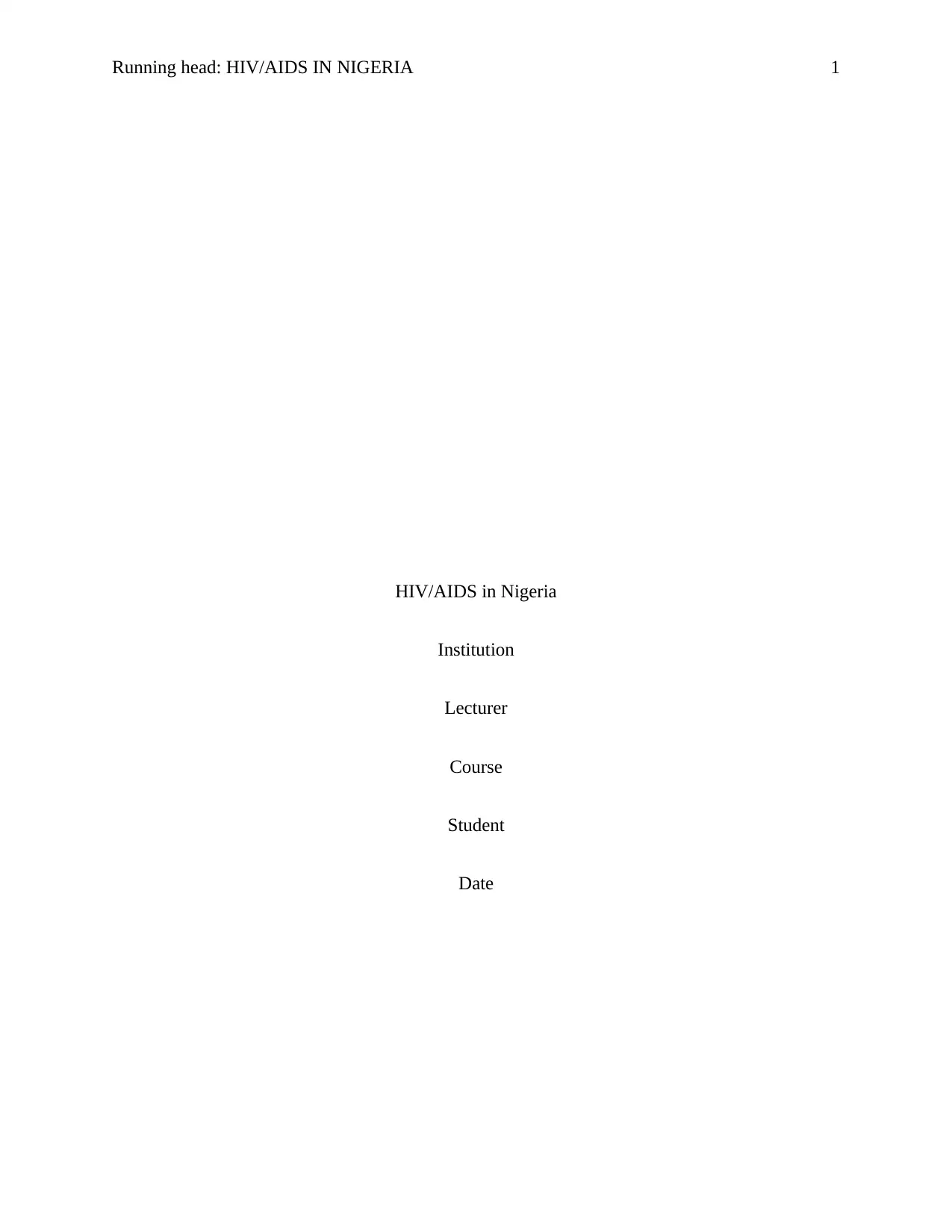
Running head: HIV/AIDS IN NIGERIA 1
HIV/AIDS in Nigeria
Institution
Lecturer
Course
Student
Date
HIV/AIDS in Nigeria
Institution
Lecturer
Course
Student
Date
Secure Best Marks with AI Grader
Need help grading? Try our AI Grader for instant feedback on your assignments.
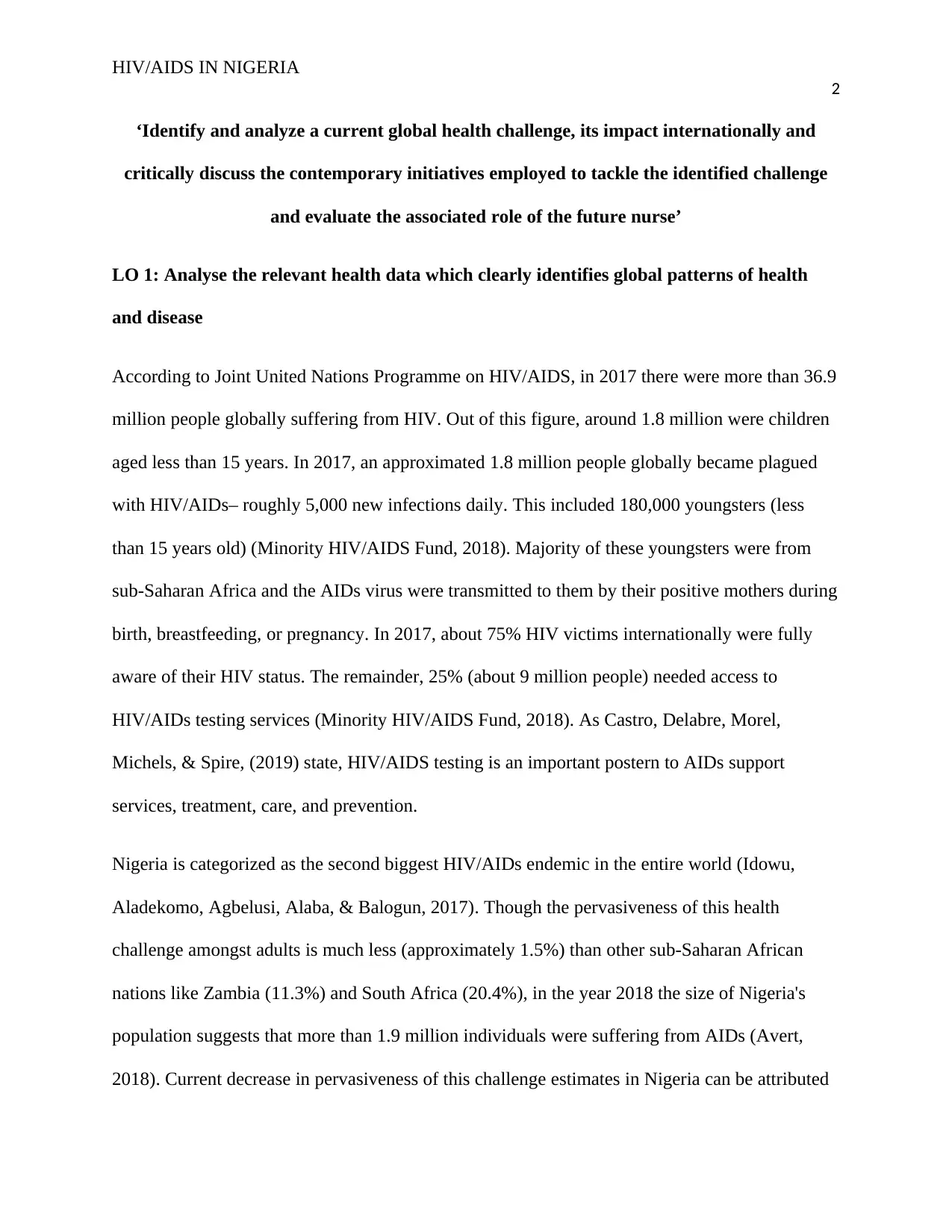
HIV/AIDS IN NIGERIA
2
‘Identify and analyze a current global health challenge, its impact internationally and
critically discuss the contemporary initiatives employed to tackle the identified challenge
and evaluate the associated role of the future nurse’
LO 1: Analyse the relevant health data which clearly identifies global patterns of health
and disease
According to Joint United Nations Programme on HIV/AIDS, in 2017 there were more than 36.9
million people globally suffering from HIV. Out of this figure, around 1.8 million were children
aged less than 15 years. In 2017, an approximated 1.8 million people globally became plagued
with HIV/AIDs– roughly 5,000 new infections daily. This included 180,000 youngsters (less
than 15 years old) (Minority HIV/AIDS Fund, 2018). Majority of these youngsters were from
sub-Saharan Africa and the AIDs virus were transmitted to them by their positive mothers during
birth, breastfeeding, or pregnancy. In 2017, about 75% HIV victims internationally were fully
aware of their HIV status. The remainder, 25% (about 9 million people) needed access to
HIV/AIDs testing services (Minority HIV/AIDS Fund, 2018). As Castro, Delabre, Morel,
Michels, & Spire, (2019) state, HIV/AIDS testing is an important postern to AIDs support
services, treatment, care, and prevention.
Nigeria is categorized as the second biggest HIV/AIDs endemic in the entire world (Idowu,
Aladekomo, Agbelusi, Alaba, & Balogun, 2017). Though the pervasiveness of this health
challenge amongst adults is much less (approximately 1.5%) than other sub-Saharan African
nations like Zambia (11.3%) and South Africa (20.4%), in the year 2018 the size of Nigeria's
population suggests that more than 1.9 million individuals were suffering from AIDs (Avert,
2018). Current decrease in pervasiveness of this challenge estimates in Nigeria can be attributed
2
‘Identify and analyze a current global health challenge, its impact internationally and
critically discuss the contemporary initiatives employed to tackle the identified challenge
and evaluate the associated role of the future nurse’
LO 1: Analyse the relevant health data which clearly identifies global patterns of health
and disease
According to Joint United Nations Programme on HIV/AIDS, in 2017 there were more than 36.9
million people globally suffering from HIV. Out of this figure, around 1.8 million were children
aged less than 15 years. In 2017, an approximated 1.8 million people globally became plagued
with HIV/AIDs– roughly 5,000 new infections daily. This included 180,000 youngsters (less
than 15 years old) (Minority HIV/AIDS Fund, 2018). Majority of these youngsters were from
sub-Saharan Africa and the AIDs virus were transmitted to them by their positive mothers during
birth, breastfeeding, or pregnancy. In 2017, about 75% HIV victims internationally were fully
aware of their HIV status. The remainder, 25% (about 9 million people) needed access to
HIV/AIDs testing services (Minority HIV/AIDS Fund, 2018). As Castro, Delabre, Morel,
Michels, & Spire, (2019) state, HIV/AIDS testing is an important postern to AIDs support
services, treatment, care, and prevention.
Nigeria is categorized as the second biggest HIV/AIDs endemic in the entire world (Idowu,
Aladekomo, Agbelusi, Alaba, & Balogun, 2017). Though the pervasiveness of this health
challenge amongst adults is much less (approximately 1.5%) than other sub-Saharan African
nations like Zambia (11.3%) and South Africa (20.4%), in the year 2018 the size of Nigeria's
population suggests that more than 1.9 million individuals were suffering from AIDs (Avert,
2018). Current decrease in pervasiveness of this challenge estimates in Nigeria can be attributed
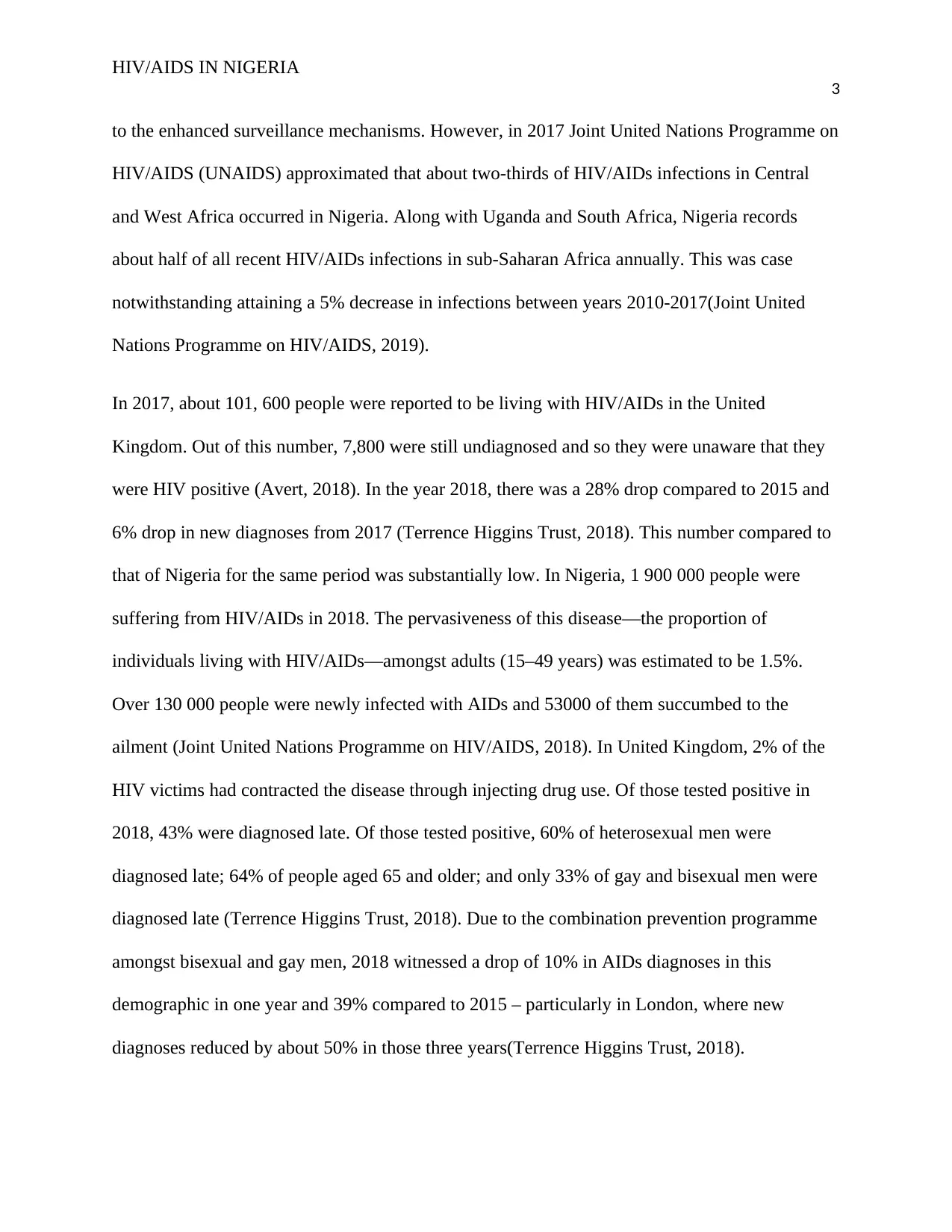
HIV/AIDS IN NIGERIA
3
to the enhanced surveillance mechanisms. However, in 2017 Joint United Nations Programme on
HIV/AIDS (UNAIDS) approximated that about two-thirds of HIV/AIDs infections in Central
and West Africa occurred in Nigeria. Along with Uganda and South Africa, Nigeria records
about half of all recent HIV/AIDs infections in sub-Saharan Africa annually. This was case
notwithstanding attaining a 5% decrease in infections between years 2010-2017(Joint United
Nations Programme on HIV/AIDS, 2019).
In 2017, about 101, 600 people were reported to be living with HIV/AIDs in the United
Kingdom. Out of this number, 7,800 were still undiagnosed and so they were unaware that they
were HIV positive (Avert, 2018). In the year 2018, there was a 28% drop compared to 2015 and
6% drop in new diagnoses from 2017 (Terrence Higgins Trust, 2018). This number compared to
that of Nigeria for the same period was substantially low. In Nigeria, 1 900 000 people were
suffering from HIV/AIDs in 2018. The pervasiveness of this disease—the proportion of
individuals living with HIV/AIDs—amongst adults (15–49 years) was estimated to be 1.5%.
Over 130 000 people were newly infected with AIDs and 53000 of them succumbed to the
ailment (Joint United Nations Programme on HIV/AIDS, 2018). In United Kingdom, 2% of the
HIV victims had contracted the disease through injecting drug use. Of those tested positive in
2018, 43% were diagnosed late. Of those tested positive, 60% of heterosexual men were
diagnosed late; 64% of people aged 65 and older; and only 33% of gay and bisexual men were
diagnosed late (Terrence Higgins Trust, 2018). Due to the combination prevention programme
amongst bisexual and gay men, 2018 witnessed a drop of 10% in AIDs diagnoses in this
demographic in one year and 39% compared to 2015 – particularly in London, where new
diagnoses reduced by about 50% in those three years(Terrence Higgins Trust, 2018).
3
to the enhanced surveillance mechanisms. However, in 2017 Joint United Nations Programme on
HIV/AIDS (UNAIDS) approximated that about two-thirds of HIV/AIDs infections in Central
and West Africa occurred in Nigeria. Along with Uganda and South Africa, Nigeria records
about half of all recent HIV/AIDs infections in sub-Saharan Africa annually. This was case
notwithstanding attaining a 5% decrease in infections between years 2010-2017(Joint United
Nations Programme on HIV/AIDS, 2019).
In 2017, about 101, 600 people were reported to be living with HIV/AIDs in the United
Kingdom. Out of this number, 7,800 were still undiagnosed and so they were unaware that they
were HIV positive (Avert, 2018). In the year 2018, there was a 28% drop compared to 2015 and
6% drop in new diagnoses from 2017 (Terrence Higgins Trust, 2018). This number compared to
that of Nigeria for the same period was substantially low. In Nigeria, 1 900 000 people were
suffering from HIV/AIDs in 2018. The pervasiveness of this disease—the proportion of
individuals living with HIV/AIDs—amongst adults (15–49 years) was estimated to be 1.5%.
Over 130 000 people were newly infected with AIDs and 53000 of them succumbed to the
ailment (Joint United Nations Programme on HIV/AIDS, 2018). In United Kingdom, 2% of the
HIV victims had contracted the disease through injecting drug use. Of those tested positive in
2018, 43% were diagnosed late. Of those tested positive, 60% of heterosexual men were
diagnosed late; 64% of people aged 65 and older; and only 33% of gay and bisexual men were
diagnosed late (Terrence Higgins Trust, 2018). Due to the combination prevention programme
amongst bisexual and gay men, 2018 witnessed a drop of 10% in AIDs diagnoses in this
demographic in one year and 39% compared to 2015 – particularly in London, where new
diagnoses reduced by about 50% in those three years(Terrence Higgins Trust, 2018).
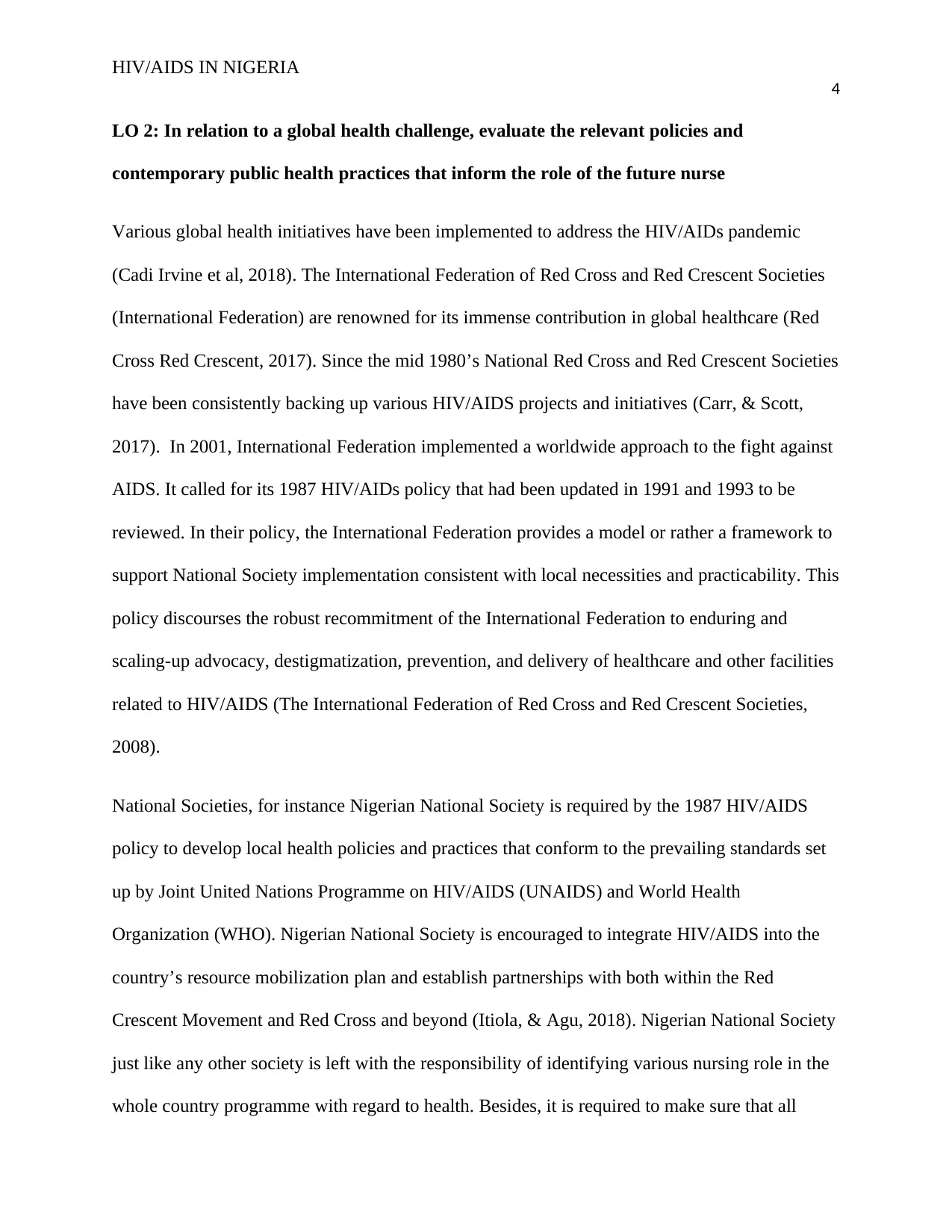
HIV/AIDS IN NIGERIA
4
LO 2: In relation to a global health challenge, evaluate the relevant policies and
contemporary public health practices that inform the role of the future nurse
Various global health initiatives have been implemented to address the HIV/AIDs pandemic
(Cadi Irvine et al, 2018). The International Federation of Red Cross and Red Crescent Societies
(International Federation) are renowned for its immense contribution in global healthcare (Red
Cross Red Crescent, 2017). Since the mid 1980’s National Red Cross and Red Crescent Societies
have been consistently backing up various HIV/AIDS projects and initiatives (Carr, & Scott,
2017). In 2001, International Federation implemented a worldwide approach to the fight against
AIDS. It called for its 1987 HIV/AIDs policy that had been updated in 1991 and 1993 to be
reviewed. In their policy, the International Federation provides a model or rather a framework to
support National Society implementation consistent with local necessities and practicability. This
policy discourses the robust recommitment of the International Federation to enduring and
scaling-up advocacy, destigmatization, prevention, and delivery of healthcare and other facilities
related to HIV/AIDS (The International Federation of Red Cross and Red Crescent Societies,
2008).
National Societies, for instance Nigerian National Society is required by the 1987 HIV/AIDS
policy to develop local health policies and practices that conform to the prevailing standards set
up by Joint United Nations Programme on HIV/AIDS (UNAIDS) and World Health
Organization (WHO). Nigerian National Society is encouraged to integrate HIV/AIDS into the
country’s resource mobilization plan and establish partnerships with both within the Red
Crescent Movement and Red Cross and beyond (Itiola, & Agu, 2018). Nigerian National Society
just like any other society is left with the responsibility of identifying various nursing role in the
whole country programme with regard to health. Besides, it is required to make sure that all
4
LO 2: In relation to a global health challenge, evaluate the relevant policies and
contemporary public health practices that inform the role of the future nurse
Various global health initiatives have been implemented to address the HIV/AIDs pandemic
(Cadi Irvine et al, 2018). The International Federation of Red Cross and Red Crescent Societies
(International Federation) are renowned for its immense contribution in global healthcare (Red
Cross Red Crescent, 2017). Since the mid 1980’s National Red Cross and Red Crescent Societies
have been consistently backing up various HIV/AIDS projects and initiatives (Carr, & Scott,
2017). In 2001, International Federation implemented a worldwide approach to the fight against
AIDS. It called for its 1987 HIV/AIDs policy that had been updated in 1991 and 1993 to be
reviewed. In their policy, the International Federation provides a model or rather a framework to
support National Society implementation consistent with local necessities and practicability. This
policy discourses the robust recommitment of the International Federation to enduring and
scaling-up advocacy, destigmatization, prevention, and delivery of healthcare and other facilities
related to HIV/AIDS (The International Federation of Red Cross and Red Crescent Societies,
2008).
National Societies, for instance Nigerian National Society is required by the 1987 HIV/AIDS
policy to develop local health policies and practices that conform to the prevailing standards set
up by Joint United Nations Programme on HIV/AIDS (UNAIDS) and World Health
Organization (WHO). Nigerian National Society is encouraged to integrate HIV/AIDS into the
country’s resource mobilization plan and establish partnerships with both within the Red
Crescent Movement and Red Cross and beyond (Itiola, & Agu, 2018). Nigerian National Society
just like any other society is left with the responsibility of identifying various nursing role in the
whole country programme with regard to health. Besides, it is required to make sure that all
Secure Best Marks with AI Grader
Need help grading? Try our AI Grader for instant feedback on your assignments.
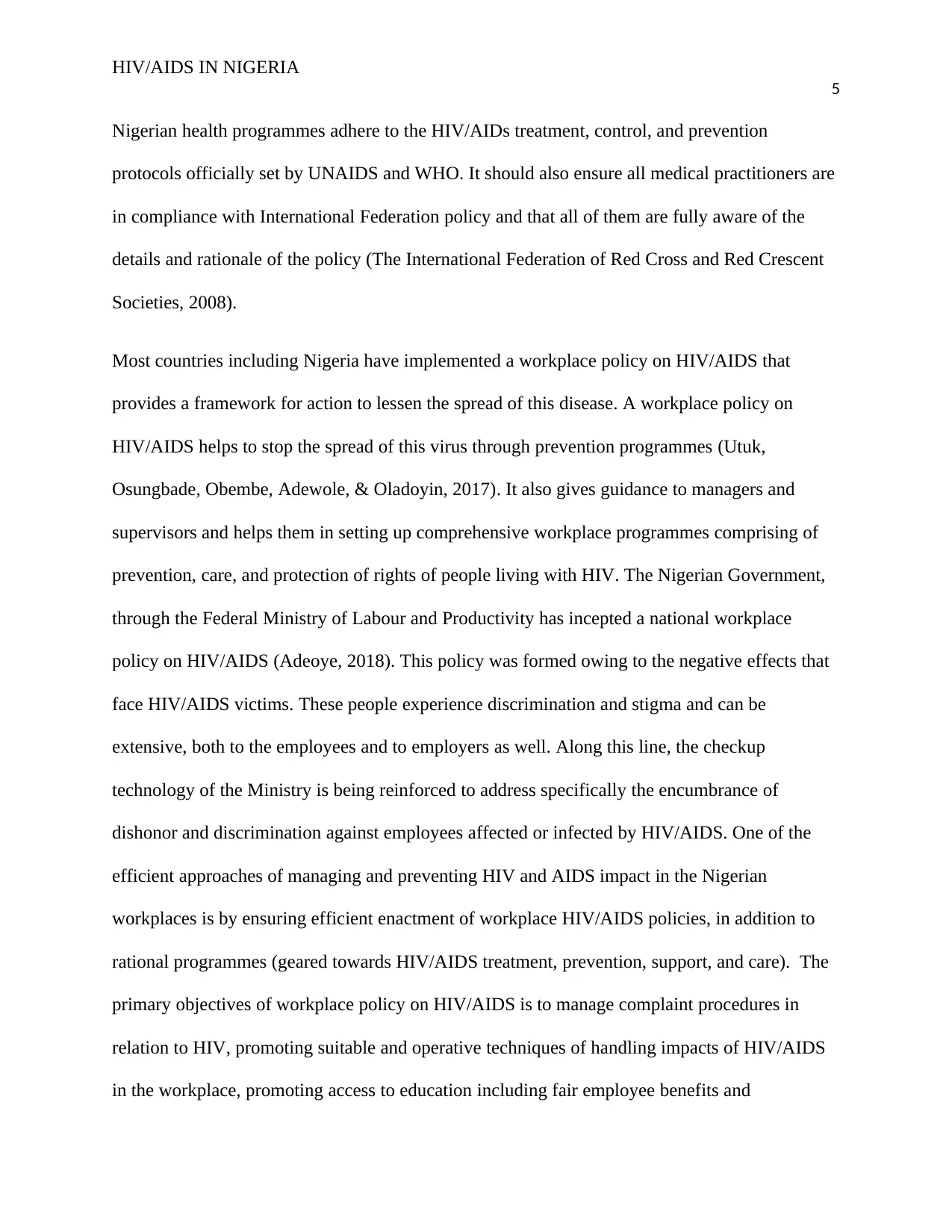
HIV/AIDS IN NIGERIA
5
Nigerian health programmes adhere to the HIV/AIDs treatment, control, and prevention
protocols officially set by UNAIDS and WHO. It should also ensure all medical practitioners are
in compliance with International Federation policy and that all of them are fully aware of the
details and rationale of the policy (The International Federation of Red Cross and Red Crescent
Societies, 2008).
Most countries including Nigeria have implemented a workplace policy on HIV/AIDS that
provides a framework for action to lessen the spread of this disease. A workplace policy on
HIV/AIDS helps to stop the spread of this virus through prevention programmes (Utuk,
Osungbade, Obembe, Adewole, & Oladoyin, 2017). It also gives guidance to managers and
supervisors and helps them in setting up comprehensive workplace programmes comprising of
prevention, care, and protection of rights of people living with HIV. The Nigerian Government,
through the Federal Ministry of Labour and Productivity has incepted a national workplace
policy on HIV/AIDS (Adeoye, 2018). This policy was formed owing to the negative effects that
face HIV/AIDS victims. These people experience discrimination and stigma and can be
extensive, both to the employees and to employers as well. Along this line, the checkup
technology of the Ministry is being reinforced to address specifically the encumbrance of
dishonor and discrimination against employees affected or infected by HIV/AIDS. One of the
efficient approaches of managing and preventing HIV and AIDS impact in the Nigerian
workplaces is by ensuring efficient enactment of workplace HIV/AIDS policies, in addition to
rational programmes (geared towards HIV/AIDS treatment, prevention, support, and care). The
primary objectives of workplace policy on HIV/AIDS is to manage complaint procedures in
relation to HIV, promoting suitable and operative techniques of handling impacts of HIV/AIDS
in the workplace, promoting access to education including fair employee benefits and
5
Nigerian health programmes adhere to the HIV/AIDs treatment, control, and prevention
protocols officially set by UNAIDS and WHO. It should also ensure all medical practitioners are
in compliance with International Federation policy and that all of them are fully aware of the
details and rationale of the policy (The International Federation of Red Cross and Red Crescent
Societies, 2008).
Most countries including Nigeria have implemented a workplace policy on HIV/AIDS that
provides a framework for action to lessen the spread of this disease. A workplace policy on
HIV/AIDS helps to stop the spread of this virus through prevention programmes (Utuk,
Osungbade, Obembe, Adewole, & Oladoyin, 2017). It also gives guidance to managers and
supervisors and helps them in setting up comprehensive workplace programmes comprising of
prevention, care, and protection of rights of people living with HIV. The Nigerian Government,
through the Federal Ministry of Labour and Productivity has incepted a national workplace
policy on HIV/AIDS (Adeoye, 2018). This policy was formed owing to the negative effects that
face HIV/AIDS victims. These people experience discrimination and stigma and can be
extensive, both to the employees and to employers as well. Along this line, the checkup
technology of the Ministry is being reinforced to address specifically the encumbrance of
dishonor and discrimination against employees affected or infected by HIV/AIDS. One of the
efficient approaches of managing and preventing HIV and AIDS impact in the Nigerian
workplaces is by ensuring efficient enactment of workplace HIV/AIDS policies, in addition to
rational programmes (geared towards HIV/AIDS treatment, prevention, support, and care). The
primary objectives of workplace policy on HIV/AIDS is to manage complaint procedures in
relation to HIV, promoting suitable and operative techniques of handling impacts of HIV/AIDS
in the workplace, promoting access to education including fair employee benefits and
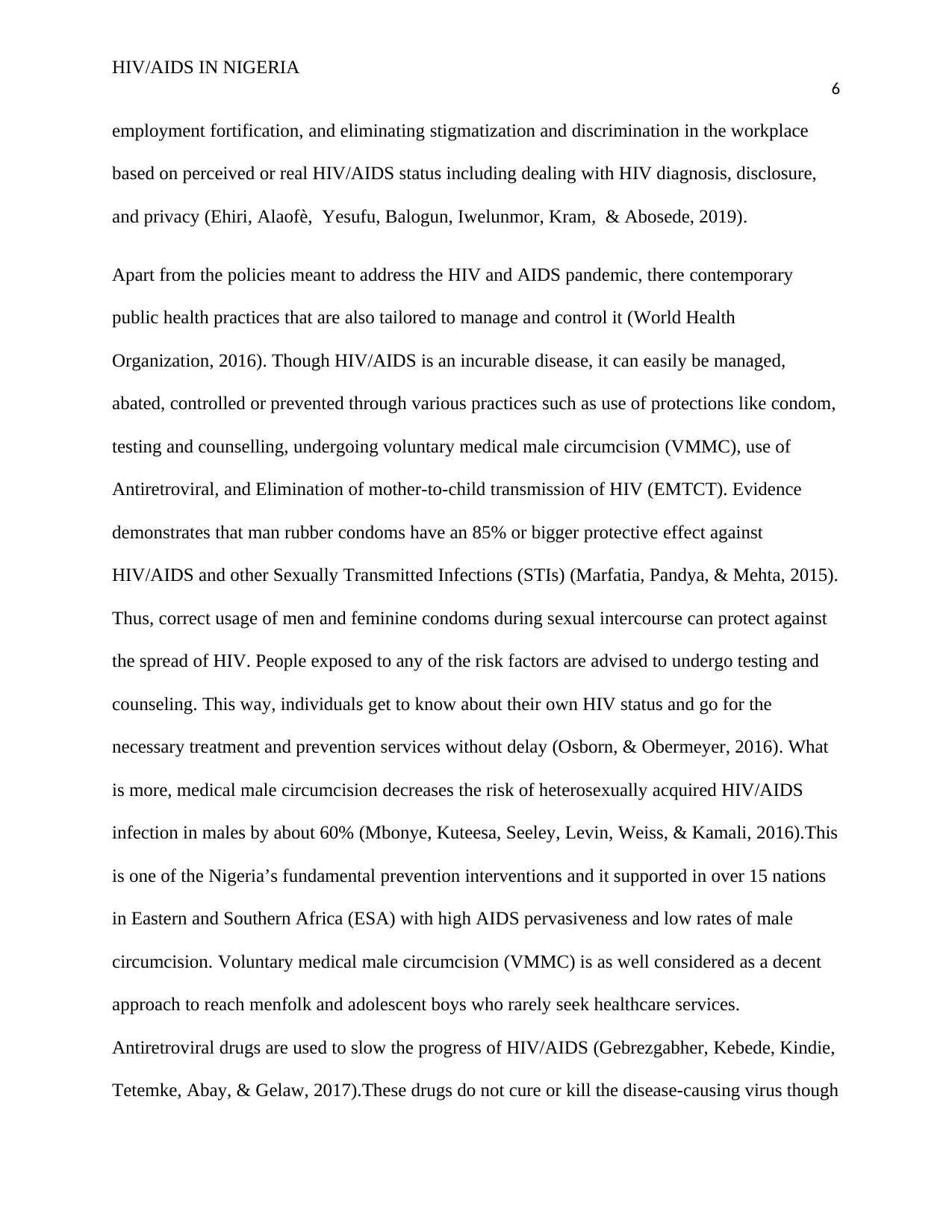
HIV/AIDS IN NIGERIA
6
employment fortification, and eliminating stigmatization and discrimination in the workplace
based on perceived or real HIV/AIDS status including dealing with HIV diagnosis, disclosure,
and privacy (Ehiri, Alaofè, Yesufu, Balogun, Iwelunmor, Kram, & Abosede, 2019).
Apart from the policies meant to address the HIV and AIDS pandemic, there contemporary
public health practices that are also tailored to manage and control it (World Health
Organization, 2016). Though HIV/AIDS is an incurable disease, it can easily be managed,
abated, controlled or prevented through various practices such as use of protections like condom,
testing and counselling, undergoing voluntary medical male circumcision (VMMC), use of
Antiretroviral, and Elimination of mother-to-child transmission of HIV (EMTCT). Evidence
demonstrates that man rubber condoms have an 85% or bigger protective effect against
HIV/AIDS and other Sexually Transmitted Infections (STIs) (Marfatia, Pandya, & Mehta, 2015).
Thus, correct usage of men and feminine condoms during sexual intercourse can protect against
the spread of HIV. People exposed to any of the risk factors are advised to undergo testing and
counseling. This way, individuals get to know about their own HIV status and go for the
necessary treatment and prevention services without delay (Osborn, & Obermeyer, 2016). What
is more, medical male circumcision decreases the risk of heterosexually acquired HIV/AIDS
infection in males by about 60% (Mbonye, Kuteesa, Seeley, Levin, Weiss, & Kamali, 2016).This
is one of the Nigeria’s fundamental prevention interventions and it supported in over 15 nations
in Eastern and Southern Africa (ESA) with high AIDS pervasiveness and low rates of male
circumcision. Voluntary medical male circumcision (VMMC) is as well considered as a decent
approach to reach menfolk and adolescent boys who rarely seek healthcare services.
Antiretroviral drugs are used to slow the progress of HIV/AIDS (Gebrezgabher, Kebede, Kindie,
Tetemke, Abay, & Gelaw, 2017).These drugs do not cure or kill the disease-causing virus though
6
employment fortification, and eliminating stigmatization and discrimination in the workplace
based on perceived or real HIV/AIDS status including dealing with HIV diagnosis, disclosure,
and privacy (Ehiri, Alaofè, Yesufu, Balogun, Iwelunmor, Kram, & Abosede, 2019).
Apart from the policies meant to address the HIV and AIDS pandemic, there contemporary
public health practices that are also tailored to manage and control it (World Health
Organization, 2016). Though HIV/AIDS is an incurable disease, it can easily be managed,
abated, controlled or prevented through various practices such as use of protections like condom,
testing and counselling, undergoing voluntary medical male circumcision (VMMC), use of
Antiretroviral, and Elimination of mother-to-child transmission of HIV (EMTCT). Evidence
demonstrates that man rubber condoms have an 85% or bigger protective effect against
HIV/AIDS and other Sexually Transmitted Infections (STIs) (Marfatia, Pandya, & Mehta, 2015).
Thus, correct usage of men and feminine condoms during sexual intercourse can protect against
the spread of HIV. People exposed to any of the risk factors are advised to undergo testing and
counseling. This way, individuals get to know about their own HIV status and go for the
necessary treatment and prevention services without delay (Osborn, & Obermeyer, 2016). What
is more, medical male circumcision decreases the risk of heterosexually acquired HIV/AIDS
infection in males by about 60% (Mbonye, Kuteesa, Seeley, Levin, Weiss, & Kamali, 2016).This
is one of the Nigeria’s fundamental prevention interventions and it supported in over 15 nations
in Eastern and Southern Africa (ESA) with high AIDS pervasiveness and low rates of male
circumcision. Voluntary medical male circumcision (VMMC) is as well considered as a decent
approach to reach menfolk and adolescent boys who rarely seek healthcare services.
Antiretroviral drugs are used to slow the progress of HIV/AIDS (Gebrezgabher, Kebede, Kindie,
Tetemke, Abay, & Gelaw, 2017).These drugs do not cure or kill the disease-causing virus though
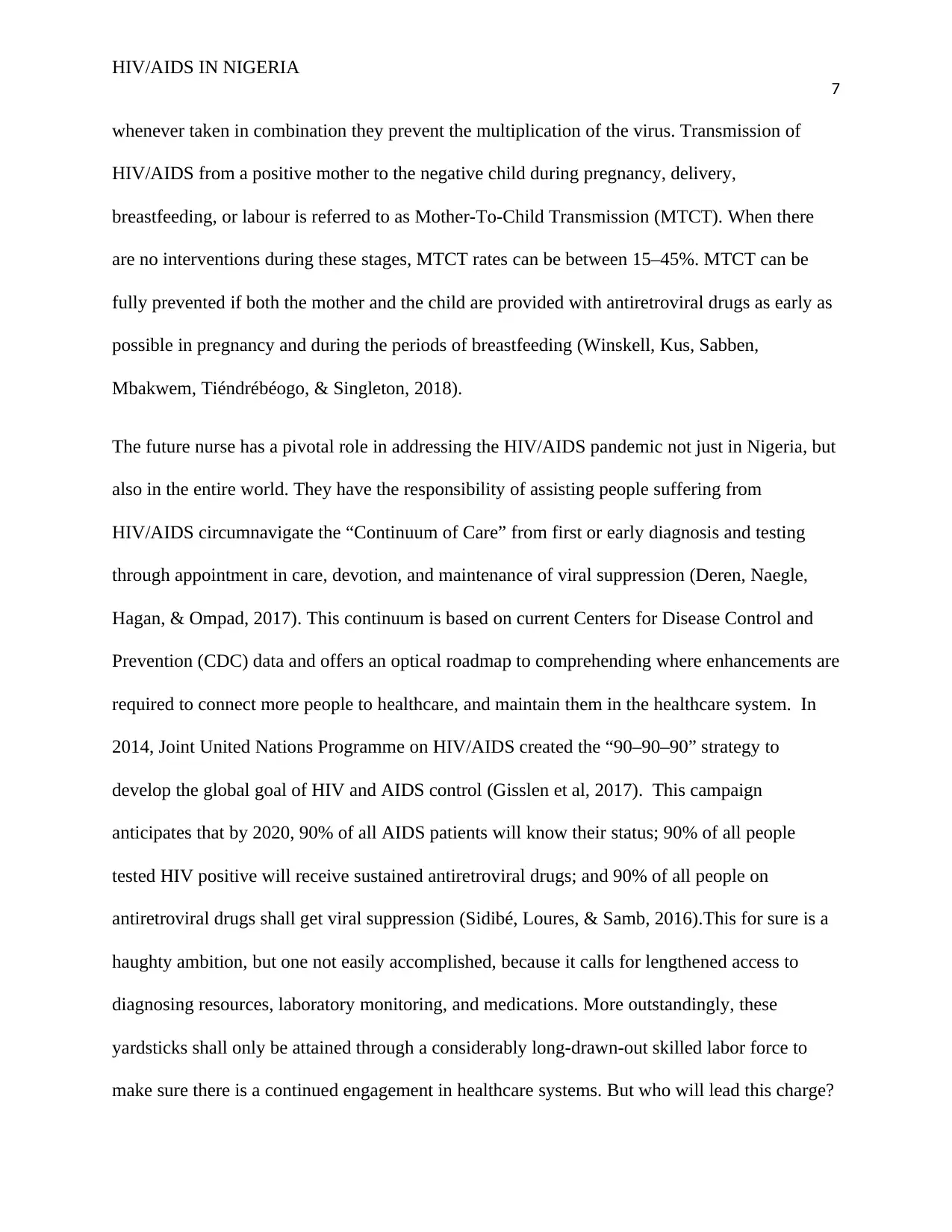
HIV/AIDS IN NIGERIA
7
whenever taken in combination they prevent the multiplication of the virus. Transmission of
HIV/AIDS from a positive mother to the negative child during pregnancy, delivery,
breastfeeding, or labour is referred to as Mother-To-Child Transmission (MTCT). When there
are no interventions during these stages, MTCT rates can be between 15–45%. MTCT can be
fully prevented if both the mother and the child are provided with antiretroviral drugs as early as
possible in pregnancy and during the periods of breastfeeding (Winskell, Kus, Sabben,
Mbakwem, Tiéndrébéogo, & Singleton, 2018).
The future nurse has a pivotal role in addressing the HIV/AIDS pandemic not just in Nigeria, but
also in the entire world. They have the responsibility of assisting people suffering from
HIV/AIDS circumnavigate the “Continuum of Care” from first or early diagnosis and testing
through appointment in care, devotion, and maintenance of viral suppression (Deren, Naegle,
Hagan, & Ompad, 2017). This continuum is based on current Centers for Disease Control and
Prevention (CDC) data and offers an optical roadmap to comprehending where enhancements are
required to connect more people to healthcare, and maintain them in the healthcare system. In
2014, Joint United Nations Programme on HIV/AIDS created the “90–90–90” strategy to
develop the global goal of HIV and AIDS control (Gisslen et al, 2017). This campaign
anticipates that by 2020, 90% of all AIDS patients will know their status; 90% of all people
tested HIV positive will receive sustained antiretroviral drugs; and 90% of all people on
antiretroviral drugs shall get viral suppression (Sidibé, Loures, & Samb, 2016).This for sure is a
haughty ambition, but one not easily accomplished, because it calls for lengthened access to
diagnosing resources, laboratory monitoring, and medications. More outstandingly, these
yardsticks shall only be attained through a considerably long-drawn-out skilled labor force to
make sure there is a continued engagement in healthcare systems. But who will lead this charge?
7
whenever taken in combination they prevent the multiplication of the virus. Transmission of
HIV/AIDS from a positive mother to the negative child during pregnancy, delivery,
breastfeeding, or labour is referred to as Mother-To-Child Transmission (MTCT). When there
are no interventions during these stages, MTCT rates can be between 15–45%. MTCT can be
fully prevented if both the mother and the child are provided with antiretroviral drugs as early as
possible in pregnancy and during the periods of breastfeeding (Winskell, Kus, Sabben,
Mbakwem, Tiéndrébéogo, & Singleton, 2018).
The future nurse has a pivotal role in addressing the HIV/AIDS pandemic not just in Nigeria, but
also in the entire world. They have the responsibility of assisting people suffering from
HIV/AIDS circumnavigate the “Continuum of Care” from first or early diagnosis and testing
through appointment in care, devotion, and maintenance of viral suppression (Deren, Naegle,
Hagan, & Ompad, 2017). This continuum is based on current Centers for Disease Control and
Prevention (CDC) data and offers an optical roadmap to comprehending where enhancements are
required to connect more people to healthcare, and maintain them in the healthcare system. In
2014, Joint United Nations Programme on HIV/AIDS created the “90–90–90” strategy to
develop the global goal of HIV and AIDS control (Gisslen et al, 2017). This campaign
anticipates that by 2020, 90% of all AIDS patients will know their status; 90% of all people
tested HIV positive will receive sustained antiretroviral drugs; and 90% of all people on
antiretroviral drugs shall get viral suppression (Sidibé, Loures, & Samb, 2016).This for sure is a
haughty ambition, but one not easily accomplished, because it calls for lengthened access to
diagnosing resources, laboratory monitoring, and medications. More outstandingly, these
yardsticks shall only be attained through a considerably long-drawn-out skilled labor force to
make sure there is a continued engagement in healthcare systems. But who will lead this charge?
Paraphrase This Document
Need a fresh take? Get an instant paraphrase of this document with our AI Paraphraser

HIV/AIDS IN NIGERIA
8
Of course the future nurses. They will be mandated to provide evidence-based and person-
centered care, commit to interprofessional cooperation, provide healthcare along the full
HIV/AIDS care continuum, ensure patients’ rights to impartial and available health care, and
provide healthcare for vulnerable and underserved populations.
LO3: Evaluate collaborative and partnership approaches, in relation to tackling global
health inequalities, across people of all ages, cultures and beliefs
There are so many organizations that engage themselves in the international response to
HIV/AIDS. These organizations work hand in hand to prevent new HIV infections and increase
access to treatment and associated health services for Nigerian people leaving with AIDS. They
include The Global Fund, International AIDS Society, Kaiser Family Foundation, UNAIDS, and
World Health Organization. The Global Fund is an organization intended to hasten the end of
HIV/AIDS, malaria, and tuberculosis epidemics (Schmidt-Traub, 2018). It works together with
private sectors, governments, technical agencies, and civil societies as well as the people infected
with the diseases. The Global Fund pools resources and invests tactically in initiatives and build
buoyant and maintainable systems for health (Clinton, & Sridhar, 2017).The Kaiser Family
Foundation (KFF) is a non-profit association that focuses on national health matters (Kates,
Wexler, & Lief, 2017).KFF develops and manages its own communications programs,
journalism, and policy analysis and it occasionally in form partnerships with major new
organizations (Rosales, & Calvo, 2019). The Joint United Nations Programme on HIV/AIDS
(UNAIDS) is an worldwide association that is focusing on bring to a halt new HIV/AIDS
infections, making sure that everybody suffering from AIDS has access to treatment, producing
data for decision-making, and promoting human rights (Seckinelgin, 2017). The World Health
Organization (WHO) guides and organizes global health undertakings within the United Nations’
8
Of course the future nurses. They will be mandated to provide evidence-based and person-
centered care, commit to interprofessional cooperation, provide healthcare along the full
HIV/AIDS care continuum, ensure patients’ rights to impartial and available health care, and
provide healthcare for vulnerable and underserved populations.
LO3: Evaluate collaborative and partnership approaches, in relation to tackling global
health inequalities, across people of all ages, cultures and beliefs
There are so many organizations that engage themselves in the international response to
HIV/AIDS. These organizations work hand in hand to prevent new HIV infections and increase
access to treatment and associated health services for Nigerian people leaving with AIDS. They
include The Global Fund, International AIDS Society, Kaiser Family Foundation, UNAIDS, and
World Health Organization. The Global Fund is an organization intended to hasten the end of
HIV/AIDS, malaria, and tuberculosis epidemics (Schmidt-Traub, 2018). It works together with
private sectors, governments, technical agencies, and civil societies as well as the people infected
with the diseases. The Global Fund pools resources and invests tactically in initiatives and build
buoyant and maintainable systems for health (Clinton, & Sridhar, 2017).The Kaiser Family
Foundation (KFF) is a non-profit association that focuses on national health matters (Kates,
Wexler, & Lief, 2017).KFF develops and manages its own communications programs,
journalism, and policy analysis and it occasionally in form partnerships with major new
organizations (Rosales, & Calvo, 2019). The Joint United Nations Programme on HIV/AIDS
(UNAIDS) is an worldwide association that is focusing on bring to a halt new HIV/AIDS
infections, making sure that everybody suffering from AIDS has access to treatment, producing
data for decision-making, and promoting human rights (Seckinelgin, 2017). The World Health
Organization (WHO) guides and organizes global health undertakings within the United Nations’
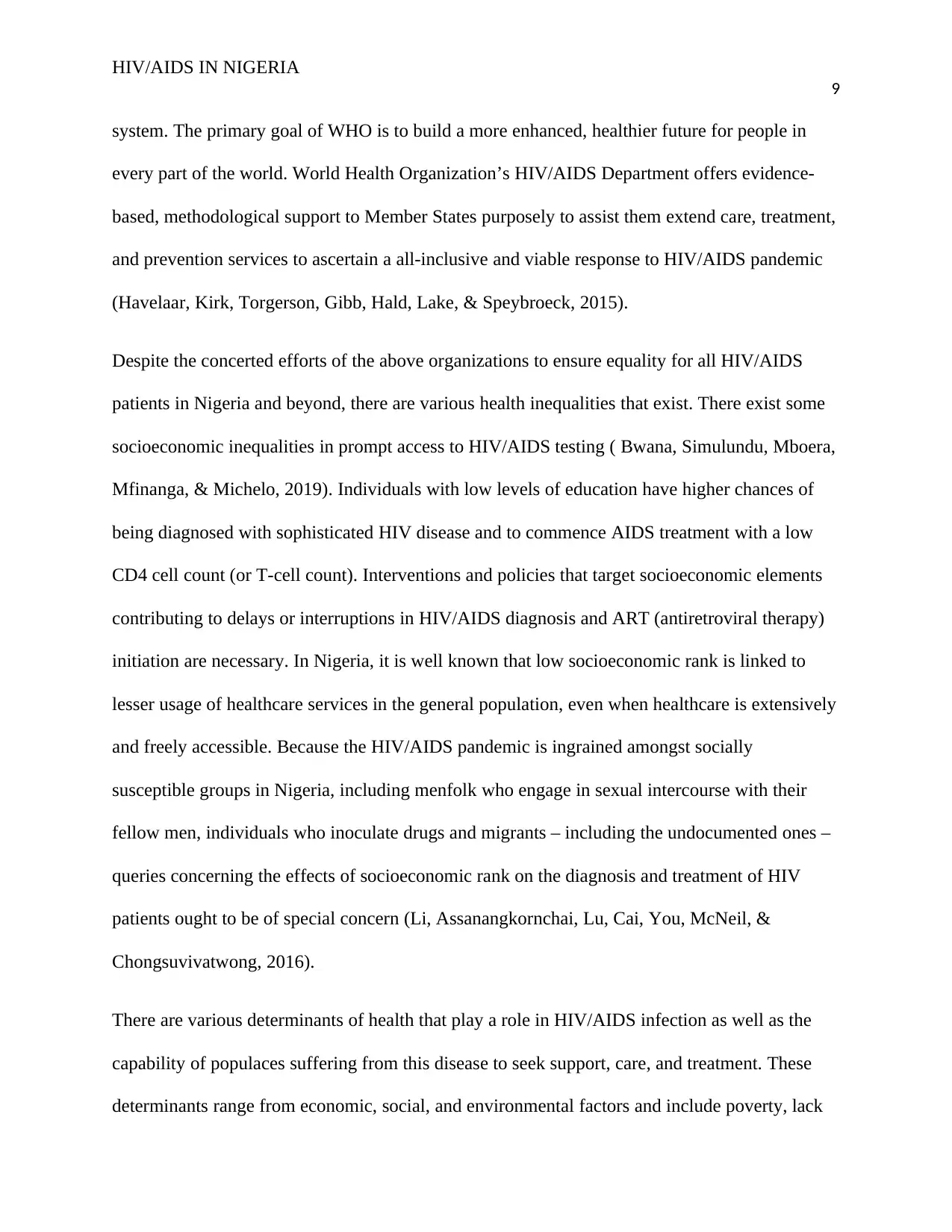
HIV/AIDS IN NIGERIA
9
system. The primary goal of WHO is to build a more enhanced, healthier future for people in
every part of the world. World Health Organization’s HIV/AIDS Department offers evidence-
based, methodological support to Member States purposely to assist them extend care, treatment,
and prevention services to ascertain a all-inclusive and viable response to HIV/AIDS pandemic
(Havelaar, Kirk, Torgerson, Gibb, Hald, Lake, & Speybroeck, 2015).
Despite the concerted efforts of the above organizations to ensure equality for all HIV/AIDS
patients in Nigeria and beyond, there are various health inequalities that exist. There exist some
socioeconomic inequalities in prompt access to HIV/AIDS testing ( Bwana, Simulundu, Mboera,
Mfinanga, & Michelo, 2019). Individuals with low levels of education have higher chances of
being diagnosed with sophisticated HIV disease and to commence AIDS treatment with a low
CD4 cell count (or T-cell count). Interventions and policies that target socioeconomic elements
contributing to delays or interruptions in HIV/AIDS diagnosis and ART (antiretroviral therapy)
initiation are necessary. In Nigeria, it is well known that low socioeconomic rank is linked to
lesser usage of healthcare services in the general population, even when healthcare is extensively
and freely accessible. Because the HIV/AIDS pandemic is ingrained amongst socially
susceptible groups in Nigeria, including menfolk who engage in sexual intercourse with their
fellow men, individuals who inoculate drugs and migrants – including the undocumented ones –
queries concerning the effects of socioeconomic rank on the diagnosis and treatment of HIV
patients ought to be of special concern (Li, Assanangkornchai, Lu, Cai, You, McNeil, &
Chongsuvivatwong, 2016).
There are various determinants of health that play a role in HIV/AIDS infection as well as the
capability of populaces suffering from this disease to seek support, care, and treatment. These
determinants range from economic, social, and environmental factors and include poverty, lack
9
system. The primary goal of WHO is to build a more enhanced, healthier future for people in
every part of the world. World Health Organization’s HIV/AIDS Department offers evidence-
based, methodological support to Member States purposely to assist them extend care, treatment,
and prevention services to ascertain a all-inclusive and viable response to HIV/AIDS pandemic
(Havelaar, Kirk, Torgerson, Gibb, Hald, Lake, & Speybroeck, 2015).
Despite the concerted efforts of the above organizations to ensure equality for all HIV/AIDS
patients in Nigeria and beyond, there are various health inequalities that exist. There exist some
socioeconomic inequalities in prompt access to HIV/AIDS testing ( Bwana, Simulundu, Mboera,
Mfinanga, & Michelo, 2019). Individuals with low levels of education have higher chances of
being diagnosed with sophisticated HIV disease and to commence AIDS treatment with a low
CD4 cell count (or T-cell count). Interventions and policies that target socioeconomic elements
contributing to delays or interruptions in HIV/AIDS diagnosis and ART (antiretroviral therapy)
initiation are necessary. In Nigeria, it is well known that low socioeconomic rank is linked to
lesser usage of healthcare services in the general population, even when healthcare is extensively
and freely accessible. Because the HIV/AIDS pandemic is ingrained amongst socially
susceptible groups in Nigeria, including menfolk who engage in sexual intercourse with their
fellow men, individuals who inoculate drugs and migrants – including the undocumented ones –
queries concerning the effects of socioeconomic rank on the diagnosis and treatment of HIV
patients ought to be of special concern (Li, Assanangkornchai, Lu, Cai, You, McNeil, &
Chongsuvivatwong, 2016).
There are various determinants of health that play a role in HIV/AIDS infection as well as the
capability of populaces suffering from this disease to seek support, care, and treatment. These
determinants range from economic, social, and environmental factors and include poverty, lack
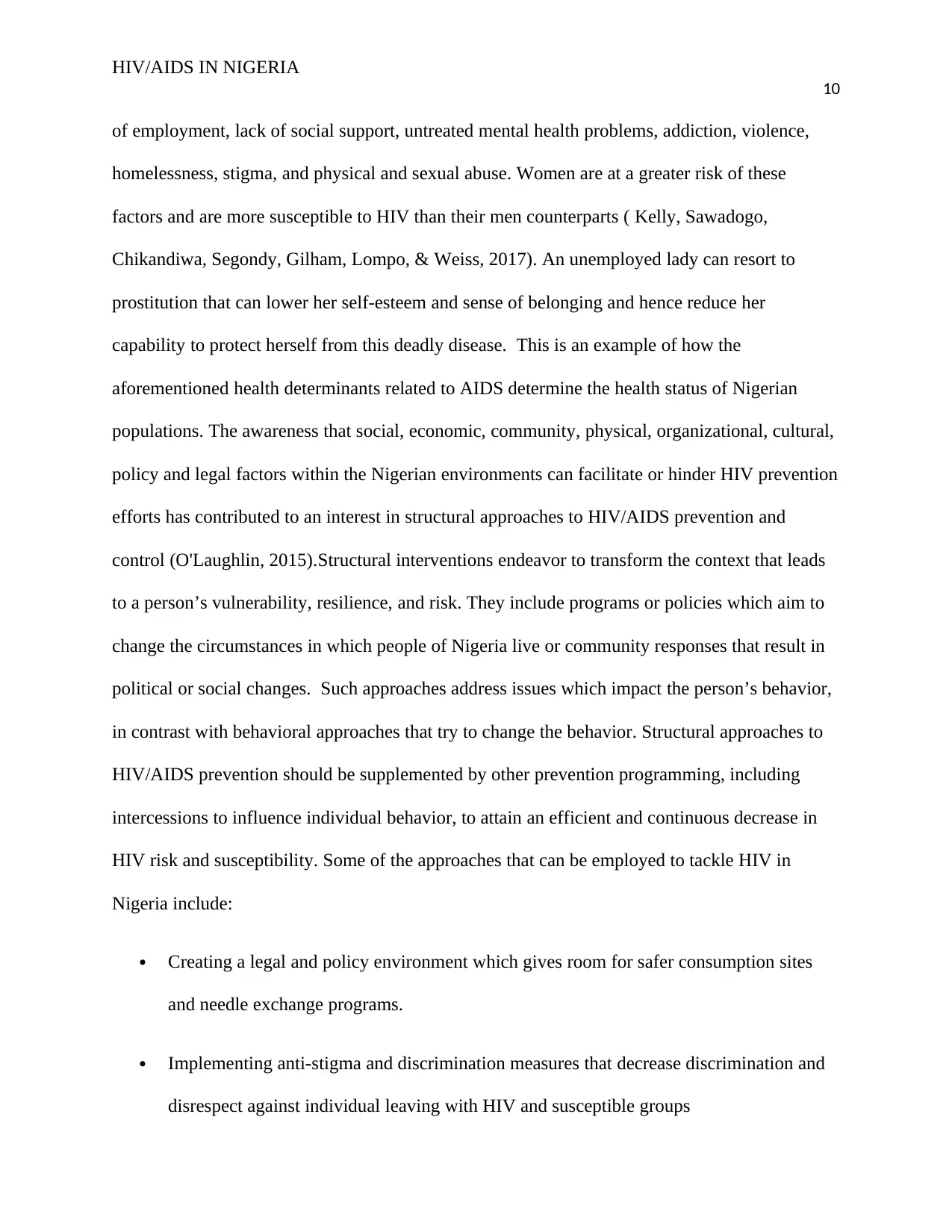
HIV/AIDS IN NIGERIA
10
of employment, lack of social support, untreated mental health problems, addiction, violence,
homelessness, stigma, and physical and sexual abuse. Women are at a greater risk of these
factors and are more susceptible to HIV than their men counterparts ( Kelly, Sawadogo,
Chikandiwa, Segondy, Gilham, Lompo, & Weiss, 2017). An unemployed lady can resort to
prostitution that can lower her self-esteem and sense of belonging and hence reduce her
capability to protect herself from this deadly disease. This is an example of how the
aforementioned health determinants related to AIDS determine the health status of Nigerian
populations. The awareness that social, economic, community, physical, organizational, cultural,
policy and legal factors within the Nigerian environments can facilitate or hinder HIV prevention
efforts has contributed to an interest in structural approaches to HIV/AIDS prevention and
control (O'Laughlin, 2015).Structural interventions endeavor to transform the context that leads
to a person’s vulnerability, resilience, and risk. They include programs or policies which aim to
change the circumstances in which people of Nigeria live or community responses that result in
political or social changes. Such approaches address issues which impact the person’s behavior,
in contrast with behavioral approaches that try to change the behavior. Structural approaches to
HIV/AIDS prevention should be supplemented by other prevention programming, including
intercessions to influence individual behavior, to attain an efficient and continuous decrease in
HIV risk and susceptibility. Some of the approaches that can be employed to tackle HIV in
Nigeria include:
Creating a legal and policy environment which gives room for safer consumption sites
and needle exchange programs.
Implementing anti-stigma and discrimination measures that decrease discrimination and
disrespect against individual leaving with HIV and susceptible groups
10
of employment, lack of social support, untreated mental health problems, addiction, violence,
homelessness, stigma, and physical and sexual abuse. Women are at a greater risk of these
factors and are more susceptible to HIV than their men counterparts ( Kelly, Sawadogo,
Chikandiwa, Segondy, Gilham, Lompo, & Weiss, 2017). An unemployed lady can resort to
prostitution that can lower her self-esteem and sense of belonging and hence reduce her
capability to protect herself from this deadly disease. This is an example of how the
aforementioned health determinants related to AIDS determine the health status of Nigerian
populations. The awareness that social, economic, community, physical, organizational, cultural,
policy and legal factors within the Nigerian environments can facilitate or hinder HIV prevention
efforts has contributed to an interest in structural approaches to HIV/AIDS prevention and
control (O'Laughlin, 2015).Structural interventions endeavor to transform the context that leads
to a person’s vulnerability, resilience, and risk. They include programs or policies which aim to
change the circumstances in which people of Nigeria live or community responses that result in
political or social changes. Such approaches address issues which impact the person’s behavior,
in contrast with behavioral approaches that try to change the behavior. Structural approaches to
HIV/AIDS prevention should be supplemented by other prevention programming, including
intercessions to influence individual behavior, to attain an efficient and continuous decrease in
HIV risk and susceptibility. Some of the approaches that can be employed to tackle HIV in
Nigeria include:
Creating a legal and policy environment which gives room for safer consumption sites
and needle exchange programs.
Implementing anti-stigma and discrimination measures that decrease discrimination and
disrespect against individual leaving with HIV and susceptible groups
Secure Best Marks with AI Grader
Need help grading? Try our AI Grader for instant feedback on your assignments.
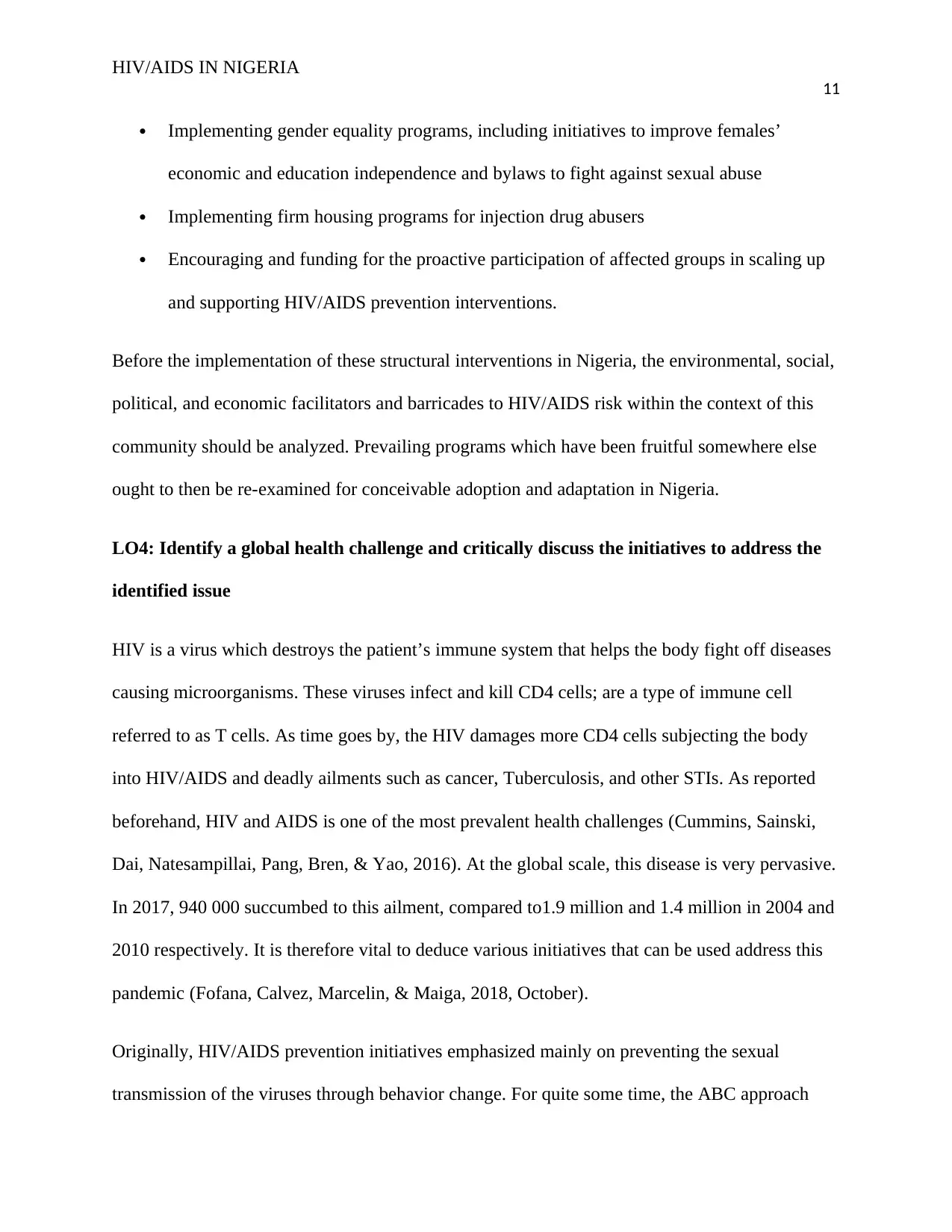
HIV/AIDS IN NIGERIA
11
Implementing gender equality programs, including initiatives to improve females’
economic and education independence and bylaws to fight against sexual abuse
Implementing firm housing programs for injection drug abusers
Encouraging and funding for the proactive participation of affected groups in scaling up
and supporting HIV/AIDS prevention interventions.
Before the implementation of these structural interventions in Nigeria, the environmental, social,
political, and economic facilitators and barricades to HIV/AIDS risk within the context of this
community should be analyzed. Prevailing programs which have been fruitful somewhere else
ought to then be re-examined for conceivable adoption and adaptation in Nigeria.
LO4: Identify a global health challenge and critically discuss the initiatives to address the
identified issue
HIV is a virus which destroys the patient’s immune system that helps the body fight off diseases
causing microorganisms. These viruses infect and kill CD4 cells; are a type of immune cell
referred to as T cells. As time goes by, the HIV damages more CD4 cells subjecting the body
into HIV/AIDS and deadly ailments such as cancer, Tuberculosis, and other STIs. As reported
beforehand, HIV and AIDS is one of the most prevalent health challenges (Cummins, Sainski,
Dai, Natesampillai, Pang, Bren, & Yao, 2016). At the global scale, this disease is very pervasive.
In 2017, 940 000 succumbed to this ailment, compared to1.9 million and 1.4 million in 2004 and
2010 respectively. It is therefore vital to deduce various initiatives that can be used address this
pandemic (Fofana, Calvez, Marcelin, & Maiga, 2018, October).
Originally, HIV/AIDS prevention initiatives emphasized mainly on preventing the sexual
transmission of the viruses through behavior change. For quite some time, the ABC approach
11
Implementing gender equality programs, including initiatives to improve females’
economic and education independence and bylaws to fight against sexual abuse
Implementing firm housing programs for injection drug abusers
Encouraging and funding for the proactive participation of affected groups in scaling up
and supporting HIV/AIDS prevention interventions.
Before the implementation of these structural interventions in Nigeria, the environmental, social,
political, and economic facilitators and barricades to HIV/AIDS risk within the context of this
community should be analyzed. Prevailing programs which have been fruitful somewhere else
ought to then be re-examined for conceivable adoption and adaptation in Nigeria.
LO4: Identify a global health challenge and critically discuss the initiatives to address the
identified issue
HIV is a virus which destroys the patient’s immune system that helps the body fight off diseases
causing microorganisms. These viruses infect and kill CD4 cells; are a type of immune cell
referred to as T cells. As time goes by, the HIV damages more CD4 cells subjecting the body
into HIV/AIDS and deadly ailments such as cancer, Tuberculosis, and other STIs. As reported
beforehand, HIV and AIDS is one of the most prevalent health challenges (Cummins, Sainski,
Dai, Natesampillai, Pang, Bren, & Yao, 2016). At the global scale, this disease is very pervasive.
In 2017, 940 000 succumbed to this ailment, compared to1.9 million and 1.4 million in 2004 and
2010 respectively. It is therefore vital to deduce various initiatives that can be used address this
pandemic (Fofana, Calvez, Marcelin, & Maiga, 2018, October).
Originally, HIV/AIDS prevention initiatives emphasized mainly on preventing the sexual
transmission of the viruses through behavior change. For quite some time, the ABC approach
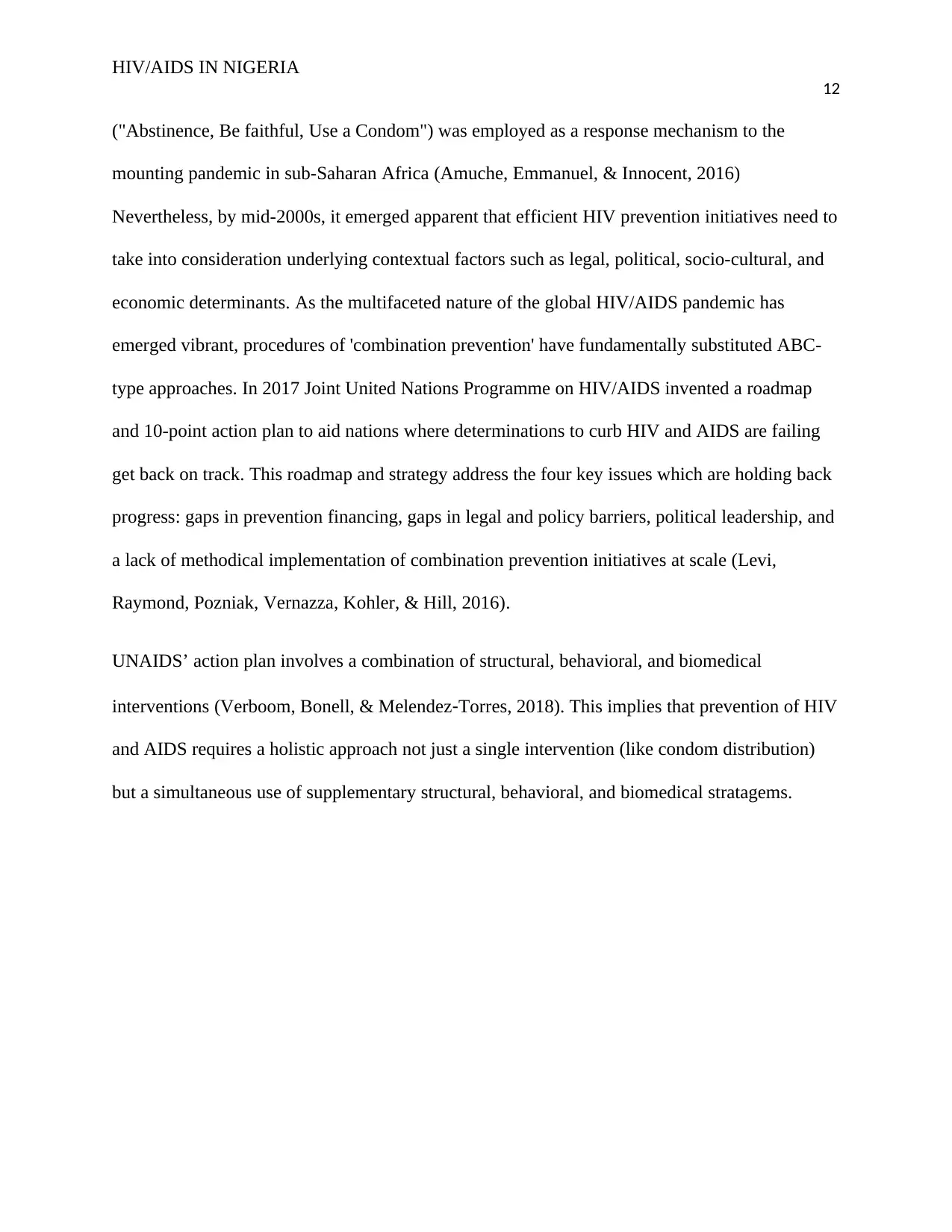
HIV/AIDS IN NIGERIA
12
("Abstinence, Be faithful, Use a Condom") was employed as a response mechanism to the
mounting pandemic in sub-Saharan Africa (Amuche, Emmanuel, & Innocent, 2016)
Nevertheless, by mid-2000s, it emerged apparent that efficient HIV prevention initiatives need to
take into consideration underlying contextual factors such as legal, political, socio-cultural, and
economic determinants. As the multifaceted nature of the global HIV/AIDS pandemic has
emerged vibrant, procedures of 'combination prevention' have fundamentally substituted ABC-
type approaches. In 2017 Joint United Nations Programme on HIV/AIDS invented a roadmap
and 10-point action plan to aid nations where determinations to curb HIV and AIDS are failing
get back on track. This roadmap and strategy address the four key issues which are holding back
progress: gaps in prevention financing, gaps in legal and policy barriers, political leadership, and
a lack of methodical implementation of combination prevention initiatives at scale (Levi,
Raymond, Pozniak, Vernazza, Kohler, & Hill, 2016).
UNAIDS’ action plan involves a combination of structural, behavioral, and biomedical
interventions (Verboom, Bonell, & Melendez‐Torres, 2018). This implies that prevention of HIV
and AIDS requires a holistic approach not just a single intervention (like condom distribution)
but a simultaneous use of supplementary structural, behavioral, and biomedical stratagems.
12
("Abstinence, Be faithful, Use a Condom") was employed as a response mechanism to the
mounting pandemic in sub-Saharan Africa (Amuche, Emmanuel, & Innocent, 2016)
Nevertheless, by mid-2000s, it emerged apparent that efficient HIV prevention initiatives need to
take into consideration underlying contextual factors such as legal, political, socio-cultural, and
economic determinants. As the multifaceted nature of the global HIV/AIDS pandemic has
emerged vibrant, procedures of 'combination prevention' have fundamentally substituted ABC-
type approaches. In 2017 Joint United Nations Programme on HIV/AIDS invented a roadmap
and 10-point action plan to aid nations where determinations to curb HIV and AIDS are failing
get back on track. This roadmap and strategy address the four key issues which are holding back
progress: gaps in prevention financing, gaps in legal and policy barriers, political leadership, and
a lack of methodical implementation of combination prevention initiatives at scale (Levi,
Raymond, Pozniak, Vernazza, Kohler, & Hill, 2016).
UNAIDS’ action plan involves a combination of structural, behavioral, and biomedical
interventions (Verboom, Bonell, & Melendez‐Torres, 2018). This implies that prevention of HIV
and AIDS requires a holistic approach not just a single intervention (like condom distribution)
but a simultaneous use of supplementary structural, behavioral, and biomedical stratagems.

HIV/AIDS IN NIGERIA
13
Ideally, combination prevention programme like this one will be more practical and suitable in
combating the HIV menace in Nigeria. This is because it puts into consideration specific factors
to each setting such as populations most affected by HIV, traditions, local culture, as well as the
levels of infrastructures. It can also be easily implemented at population, community, and
individual levels. The Government of Nigeria should therefore call for this combined approach to
HIV/AIDS prevention to be intensified and make a continuous impact on global HIV incidence
rates by reinvigorating the global response.
Joint United Nations Programme on HIV/AIDS defines this combination prevention as: rights-
based, community-owned and evidence-informed programmes that utilize a combination of
structural, behavioral, and biomedical interventions, arranged to meet the contemporary
HIV/AIDS prevention necessities of specific communities and individuals, in order to have the
utmost continuous impact on plummeting newfangled infections. Every combination prevention
13
Ideally, combination prevention programme like this one will be more practical and suitable in
combating the HIV menace in Nigeria. This is because it puts into consideration specific factors
to each setting such as populations most affected by HIV, traditions, local culture, as well as the
levels of infrastructures. It can also be easily implemented at population, community, and
individual levels. The Government of Nigeria should therefore call for this combined approach to
HIV/AIDS prevention to be intensified and make a continuous impact on global HIV incidence
rates by reinvigorating the global response.
Joint United Nations Programme on HIV/AIDS defines this combination prevention as: rights-
based, community-owned and evidence-informed programmes that utilize a combination of
structural, behavioral, and biomedical interventions, arranged to meet the contemporary
HIV/AIDS prevention necessities of specific communities and individuals, in order to have the
utmost continuous impact on plummeting newfangled infections. Every combination prevention
Paraphrase This Document
Need a fresh take? Get an instant paraphrase of this document with our AI Paraphraser

HIV/AIDS IN NIGERIA
14
initiative requires a robust public empowerment component and detailed determinations to
address policy and legal obstacles, as well as the solidification of social and health protection
schemes, plus systems to address discrimination, stigma and gender inequality. For example:
Young people in high prevalence regions in the United Kingdom require more than condoms and
behavior transformation communications. They need all-inclusive edification on sexuality and
access to efficient HIV/AIDS and reproductive and sexual health amenities without structural
hurdles, like parental consent laws or socioeconomic impediments, like prohibitive costs.
Conclusion
HIV/AIDS is one the most prevalent health challenges globally. HIV is an abbreviation for
Human Immunodeficiency Virus, which is the virus that leads to HIV infection. “HIV” stands
for the virus or the HIV infection. AIDS is an abbreviation for Immunodeficiency Syndrome and
it is the most advanced phase of HIV infection. HIV damages the CD4 cells of the immune
system responsible for fighting-off disease causing microorganisms. If HIV is not treated, it
progresses and leads to AIDS. In Nigeria, HIV prevalence rate amongst the adults (aged 15-49)
is approximated at 1.4%. This prevalence is very multifaceted and varies from one region to
another. In some regions, this pandemic is more concentrated and caused by high-risk people
behaviors, whilst other regions have more widespread endemics persistent mainly due to
numerous sexual partnerships in the general populace. There are various global organizations
that are attempting to develop initiatives that can manage this pandemic not just in Nigeria, but
also in the entire world. One of these organizations is UNAIDS that has developed a combination
prevention programme and replaced the conventional one that emphasized only on Abstinence,
Be faithful, Use a Condom (ABC). This programme involves a combination of structural,
14
initiative requires a robust public empowerment component and detailed determinations to
address policy and legal obstacles, as well as the solidification of social and health protection
schemes, plus systems to address discrimination, stigma and gender inequality. For example:
Young people in high prevalence regions in the United Kingdom require more than condoms and
behavior transformation communications. They need all-inclusive edification on sexuality and
access to efficient HIV/AIDS and reproductive and sexual health amenities without structural
hurdles, like parental consent laws or socioeconomic impediments, like prohibitive costs.
Conclusion
HIV/AIDS is one the most prevalent health challenges globally. HIV is an abbreviation for
Human Immunodeficiency Virus, which is the virus that leads to HIV infection. “HIV” stands
for the virus or the HIV infection. AIDS is an abbreviation for Immunodeficiency Syndrome and
it is the most advanced phase of HIV infection. HIV damages the CD4 cells of the immune
system responsible for fighting-off disease causing microorganisms. If HIV is not treated, it
progresses and leads to AIDS. In Nigeria, HIV prevalence rate amongst the adults (aged 15-49)
is approximated at 1.4%. This prevalence is very multifaceted and varies from one region to
another. In some regions, this pandemic is more concentrated and caused by high-risk people
behaviors, whilst other regions have more widespread endemics persistent mainly due to
numerous sexual partnerships in the general populace. There are various global organizations
that are attempting to develop initiatives that can manage this pandemic not just in Nigeria, but
also in the entire world. One of these organizations is UNAIDS that has developed a combination
prevention programme and replaced the conventional one that emphasized only on Abstinence,
Be faithful, Use a Condom (ABC). This programme involves a combination of structural,

HIV/AIDS IN NIGERIA
15
behavioral, and biomedical interventions and it expected to reduce the prevalence of HIV and
AIDS by a very huge margin.
15
behavioral, and biomedical interventions and it expected to reduce the prevalence of HIV and
AIDS by a very huge margin.
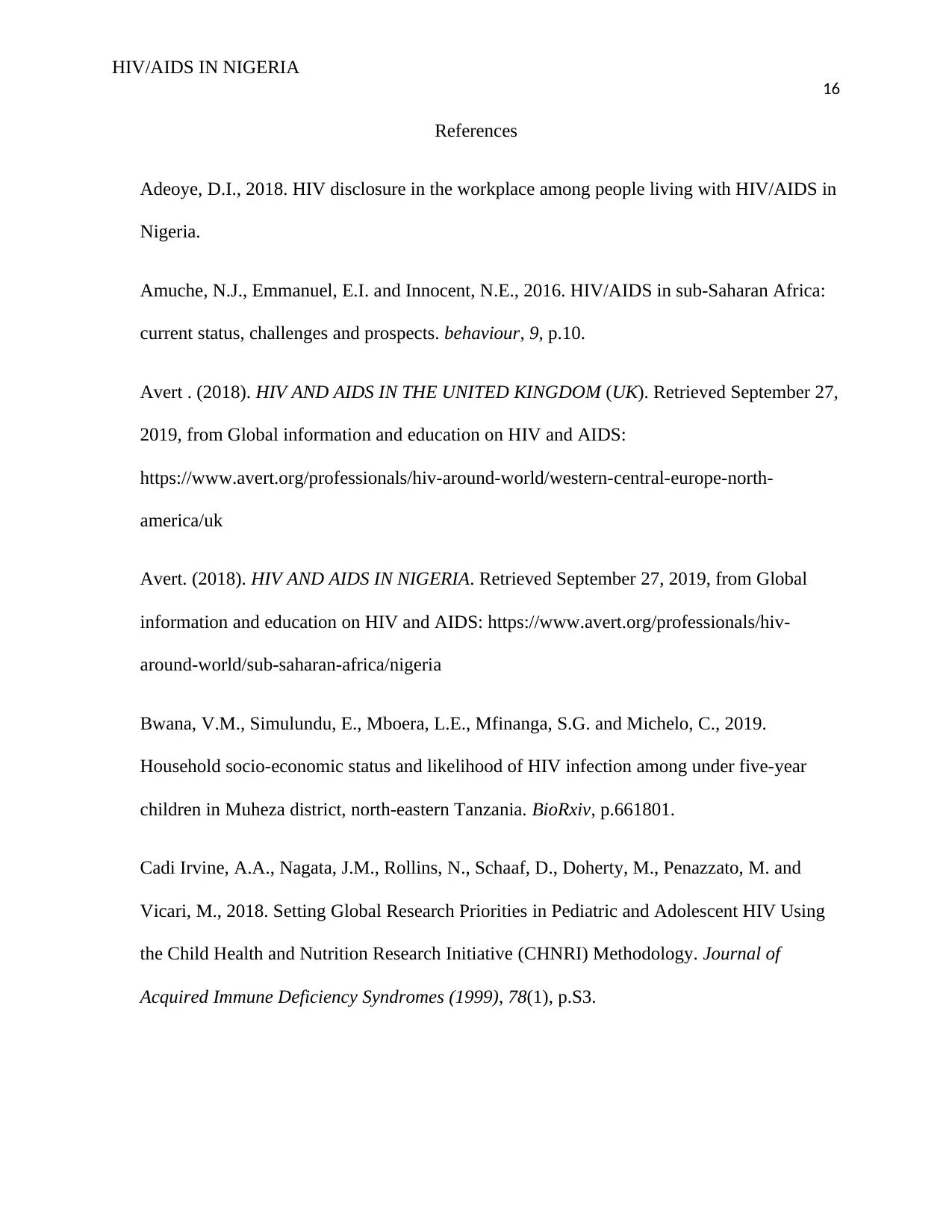
HIV/AIDS IN NIGERIA
16
References
Adeoye, D.I., 2018. HIV disclosure in the workplace among people living with HIV/AIDS in
Nigeria.
Amuche, N.J., Emmanuel, E.I. and Innocent, N.E., 2016. HIV/AIDS in sub-Saharan Africa:
current status, challenges and prospects. behaviour, 9, p.10.
Avert . (2018). HIV AND AIDS IN THE UNITED KINGDOM (UK). Retrieved September 27,
2019, from Global information and education on HIV and AIDS:
https://www.avert.org/professionals/hiv-around-world/western-central-europe-north-
america/uk
Avert. (2018). HIV AND AIDS IN NIGERIA. Retrieved September 27, 2019, from Global
information and education on HIV and AIDS: https://www.avert.org/professionals/hiv-
around-world/sub-saharan-africa/nigeria
Bwana, V.M., Simulundu, E., Mboera, L.E., Mfinanga, S.G. and Michelo, C., 2019.
Household socio-economic status and likelihood of HIV infection among under five-year
children in Muheza district, north-eastern Tanzania. BioRxiv, p.661801.
Cadi Irvine, A.A., Nagata, J.M., Rollins, N., Schaaf, D., Doherty, M., Penazzato, M. and
Vicari, M., 2018. Setting Global Research Priorities in Pediatric and Adolescent HIV Using
the Child Health and Nutrition Research Initiative (CHNRI) Methodology. Journal of
Acquired Immune Deficiency Syndromes (1999), 78(1), p.S3.
16
References
Adeoye, D.I., 2018. HIV disclosure in the workplace among people living with HIV/AIDS in
Nigeria.
Amuche, N.J., Emmanuel, E.I. and Innocent, N.E., 2016. HIV/AIDS in sub-Saharan Africa:
current status, challenges and prospects. behaviour, 9, p.10.
Avert . (2018). HIV AND AIDS IN THE UNITED KINGDOM (UK). Retrieved September 27,
2019, from Global information and education on HIV and AIDS:
https://www.avert.org/professionals/hiv-around-world/western-central-europe-north-
america/uk
Avert. (2018). HIV AND AIDS IN NIGERIA. Retrieved September 27, 2019, from Global
information and education on HIV and AIDS: https://www.avert.org/professionals/hiv-
around-world/sub-saharan-africa/nigeria
Bwana, V.M., Simulundu, E., Mboera, L.E., Mfinanga, S.G. and Michelo, C., 2019.
Household socio-economic status and likelihood of HIV infection among under five-year
children in Muheza district, north-eastern Tanzania. BioRxiv, p.661801.
Cadi Irvine, A.A., Nagata, J.M., Rollins, N., Schaaf, D., Doherty, M., Penazzato, M. and
Vicari, M., 2018. Setting Global Research Priorities in Pediatric and Adolescent HIV Using
the Child Health and Nutrition Research Initiative (CHNRI) Methodology. Journal of
Acquired Immune Deficiency Syndromes (1999), 78(1), p.S3.
Secure Best Marks with AI Grader
Need help grading? Try our AI Grader for instant feedback on your assignments.
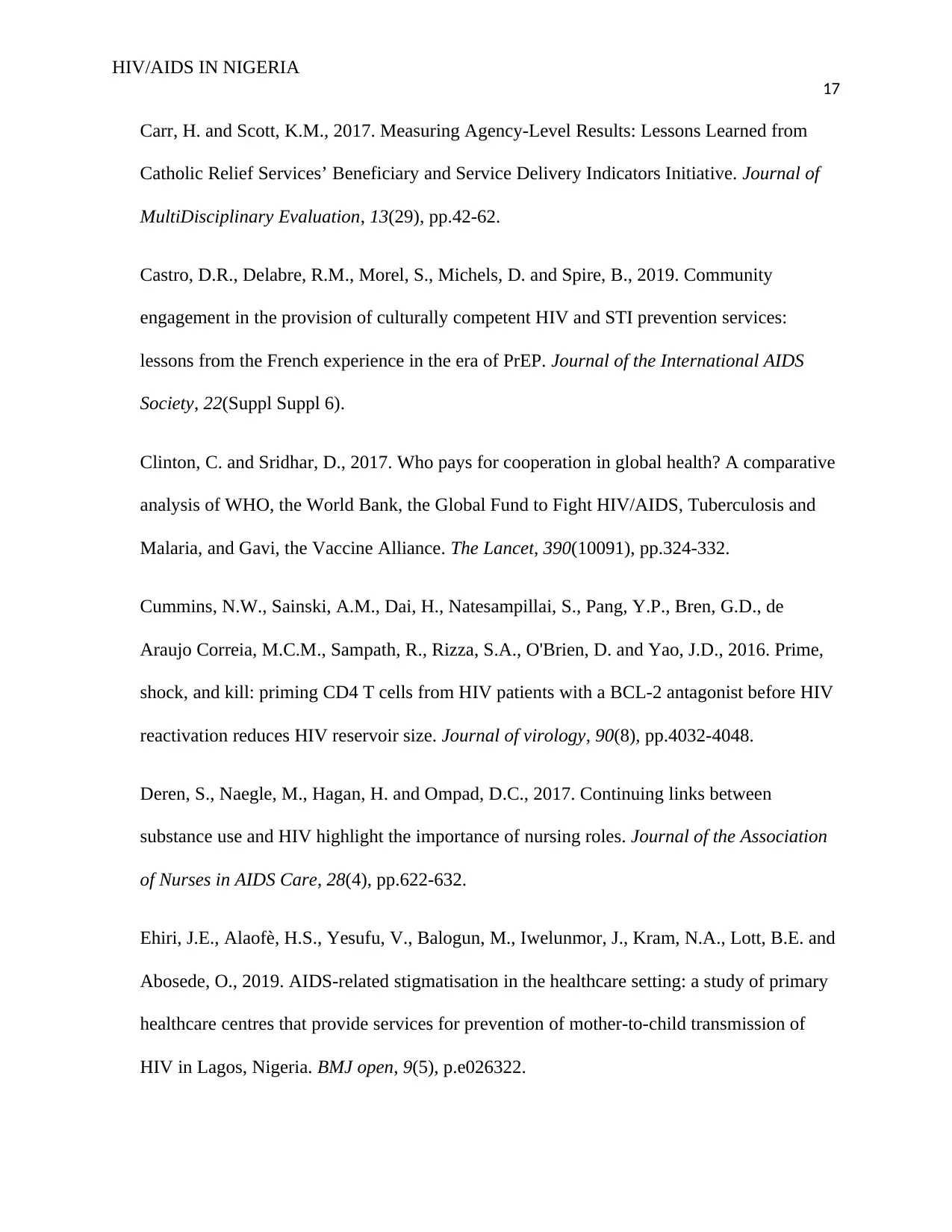
HIV/AIDS IN NIGERIA
17
Carr, H. and Scott, K.M., 2017. Measuring Agency-Level Results: Lessons Learned from
Catholic Relief Services’ Beneficiary and Service Delivery Indicators Initiative. Journal of
MultiDisciplinary Evaluation, 13(29), pp.42-62.
Castro, D.R., Delabre, R.M., Morel, S., Michels, D. and Spire, B., 2019. Community
engagement in the provision of culturally competent HIV and STI prevention services:
lessons from the French experience in the era of PrEP. Journal of the International AIDS
Society, 22(Suppl Suppl 6).
Clinton, C. and Sridhar, D., 2017. Who pays for cooperation in global health? A comparative
analysis of WHO, the World Bank, the Global Fund to Fight HIV/AIDS, Tuberculosis and
Malaria, and Gavi, the Vaccine Alliance. The Lancet, 390(10091), pp.324-332.
Cummins, N.W., Sainski, A.M., Dai, H., Natesampillai, S., Pang, Y.P., Bren, G.D., de
Araujo Correia, M.C.M., Sampath, R., Rizza, S.A., O'Brien, D. and Yao, J.D., 2016. Prime,
shock, and kill: priming CD4 T cells from HIV patients with a BCL-2 antagonist before HIV
reactivation reduces HIV reservoir size. Journal of virology, 90(8), pp.4032-4048.
Deren, S., Naegle, M., Hagan, H. and Ompad, D.C., 2017. Continuing links between
substance use and HIV highlight the importance of nursing roles. Journal of the Association
of Nurses in AIDS Care, 28(4), pp.622-632.
Ehiri, J.E., Alaofè, H.S., Yesufu, V., Balogun, M., Iwelunmor, J., Kram, N.A., Lott, B.E. and
Abosede, O., 2019. AIDS-related stigmatisation in the healthcare setting: a study of primary
healthcare centres that provide services for prevention of mother-to-child transmission of
HIV in Lagos, Nigeria. BMJ open, 9(5), p.e026322.
17
Carr, H. and Scott, K.M., 2017. Measuring Agency-Level Results: Lessons Learned from
Catholic Relief Services’ Beneficiary and Service Delivery Indicators Initiative. Journal of
MultiDisciplinary Evaluation, 13(29), pp.42-62.
Castro, D.R., Delabre, R.M., Morel, S., Michels, D. and Spire, B., 2019. Community
engagement in the provision of culturally competent HIV and STI prevention services:
lessons from the French experience in the era of PrEP. Journal of the International AIDS
Society, 22(Suppl Suppl 6).
Clinton, C. and Sridhar, D., 2017. Who pays for cooperation in global health? A comparative
analysis of WHO, the World Bank, the Global Fund to Fight HIV/AIDS, Tuberculosis and
Malaria, and Gavi, the Vaccine Alliance. The Lancet, 390(10091), pp.324-332.
Cummins, N.W., Sainski, A.M., Dai, H., Natesampillai, S., Pang, Y.P., Bren, G.D., de
Araujo Correia, M.C.M., Sampath, R., Rizza, S.A., O'Brien, D. and Yao, J.D., 2016. Prime,
shock, and kill: priming CD4 T cells from HIV patients with a BCL-2 antagonist before HIV
reactivation reduces HIV reservoir size. Journal of virology, 90(8), pp.4032-4048.
Deren, S., Naegle, M., Hagan, H. and Ompad, D.C., 2017. Continuing links between
substance use and HIV highlight the importance of nursing roles. Journal of the Association
of Nurses in AIDS Care, 28(4), pp.622-632.
Ehiri, J.E., Alaofè, H.S., Yesufu, V., Balogun, M., Iwelunmor, J., Kram, N.A., Lott, B.E. and
Abosede, O., 2019. AIDS-related stigmatisation in the healthcare setting: a study of primary
healthcare centres that provide services for prevention of mother-to-child transmission of
HIV in Lagos, Nigeria. BMJ open, 9(5), p.e026322.
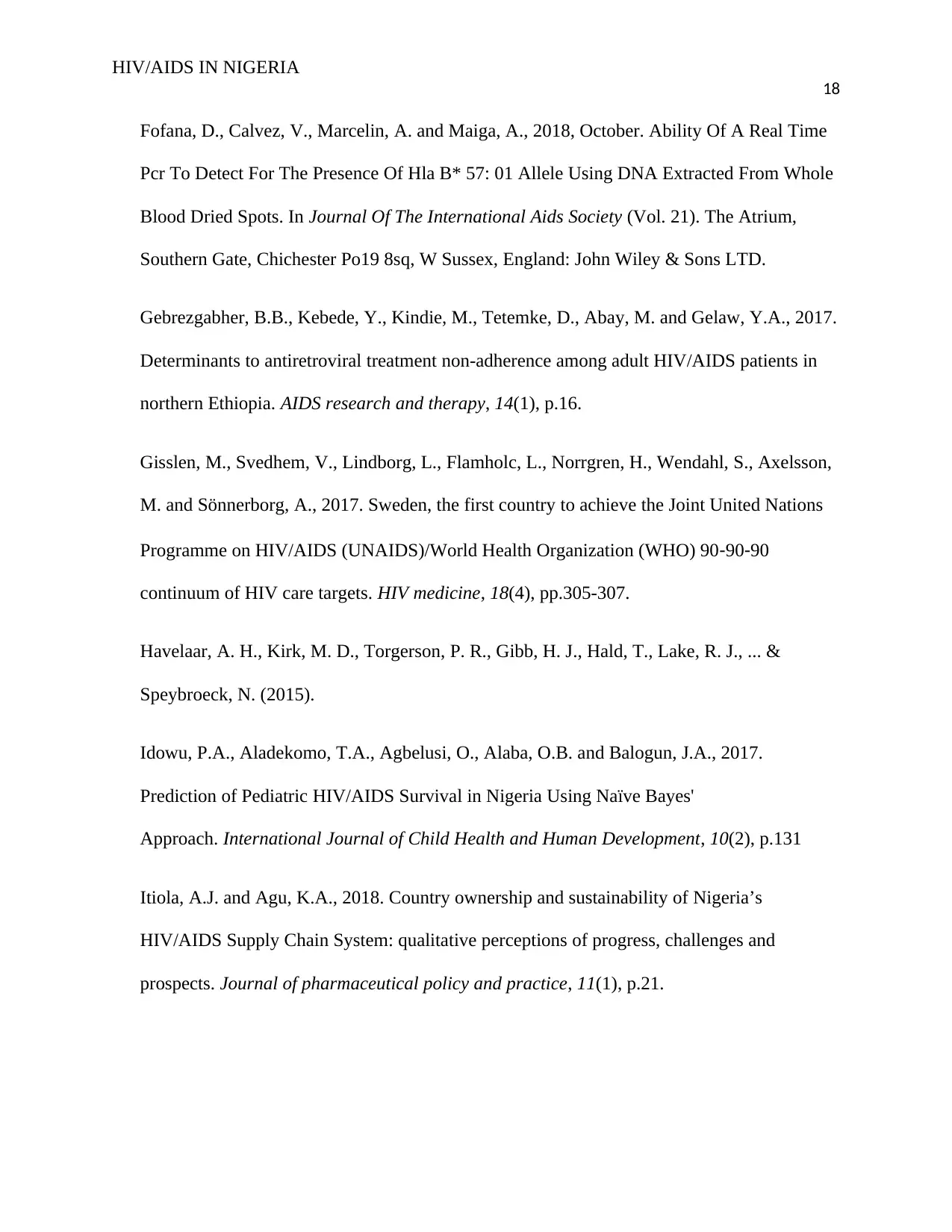
HIV/AIDS IN NIGERIA
18
Fofana, D., Calvez, V., Marcelin, A. and Maiga, A., 2018, October. Ability Of A Real Time
Pcr To Detect For The Presence Of Hla B* 57: 01 Allele Using DNA Extracted From Whole
Blood Dried Spots. In Journal Of The International Aids Society (Vol. 21). The Atrium,
Southern Gate, Chichester Po19 8sq, W Sussex, England: John Wiley & Sons LTD.
Gebrezgabher, B.B., Kebede, Y., Kindie, M., Tetemke, D., Abay, M. and Gelaw, Y.A., 2017.
Determinants to antiretroviral treatment non-adherence among adult HIV/AIDS patients in
northern Ethiopia. AIDS research and therapy, 14(1), p.16.
Gisslen, M., Svedhem, V., Lindborg, L., Flamholc, L., Norrgren, H., Wendahl, S., Axelsson,
M. and Sönnerborg, A., 2017. Sweden, the first country to achieve the Joint United Nations
Programme on HIV/AIDS (UNAIDS)/World Health Organization (WHO) 90‐90‐90
continuum of HIV care targets. HIV medicine, 18(4), pp.305-307.
Havelaar, A. H., Kirk, M. D., Torgerson, P. R., Gibb, H. J., Hald, T., Lake, R. J., ... &
Speybroeck, N. (2015).
Idowu, P.A., Aladekomo, T.A., Agbelusi, O., Alaba, O.B. and Balogun, J.A., 2017.
Prediction of Pediatric HIV/AIDS Survival in Nigeria Using Naïve Bayes'
Approach. International Journal of Child Health and Human Development, 10(2), p.131
Itiola, A.J. and Agu, K.A., 2018. Country ownership and sustainability of Nigeria’s
HIV/AIDS Supply Chain System: qualitative perceptions of progress, challenges and
prospects. Journal of pharmaceutical policy and practice, 11(1), p.21.
18
Fofana, D., Calvez, V., Marcelin, A. and Maiga, A., 2018, October. Ability Of A Real Time
Pcr To Detect For The Presence Of Hla B* 57: 01 Allele Using DNA Extracted From Whole
Blood Dried Spots. In Journal Of The International Aids Society (Vol. 21). The Atrium,
Southern Gate, Chichester Po19 8sq, W Sussex, England: John Wiley & Sons LTD.
Gebrezgabher, B.B., Kebede, Y., Kindie, M., Tetemke, D., Abay, M. and Gelaw, Y.A., 2017.
Determinants to antiretroviral treatment non-adherence among adult HIV/AIDS patients in
northern Ethiopia. AIDS research and therapy, 14(1), p.16.
Gisslen, M., Svedhem, V., Lindborg, L., Flamholc, L., Norrgren, H., Wendahl, S., Axelsson,
M. and Sönnerborg, A., 2017. Sweden, the first country to achieve the Joint United Nations
Programme on HIV/AIDS (UNAIDS)/World Health Organization (WHO) 90‐90‐90
continuum of HIV care targets. HIV medicine, 18(4), pp.305-307.
Havelaar, A. H., Kirk, M. D., Torgerson, P. R., Gibb, H. J., Hald, T., Lake, R. J., ... &
Speybroeck, N. (2015).
Idowu, P.A., Aladekomo, T.A., Agbelusi, O., Alaba, O.B. and Balogun, J.A., 2017.
Prediction of Pediatric HIV/AIDS Survival in Nigeria Using Naïve Bayes'
Approach. International Journal of Child Health and Human Development, 10(2), p.131
Itiola, A.J. and Agu, K.A., 2018. Country ownership and sustainability of Nigeria’s
HIV/AIDS Supply Chain System: qualitative perceptions of progress, challenges and
prospects. Journal of pharmaceutical policy and practice, 11(1), p.21.
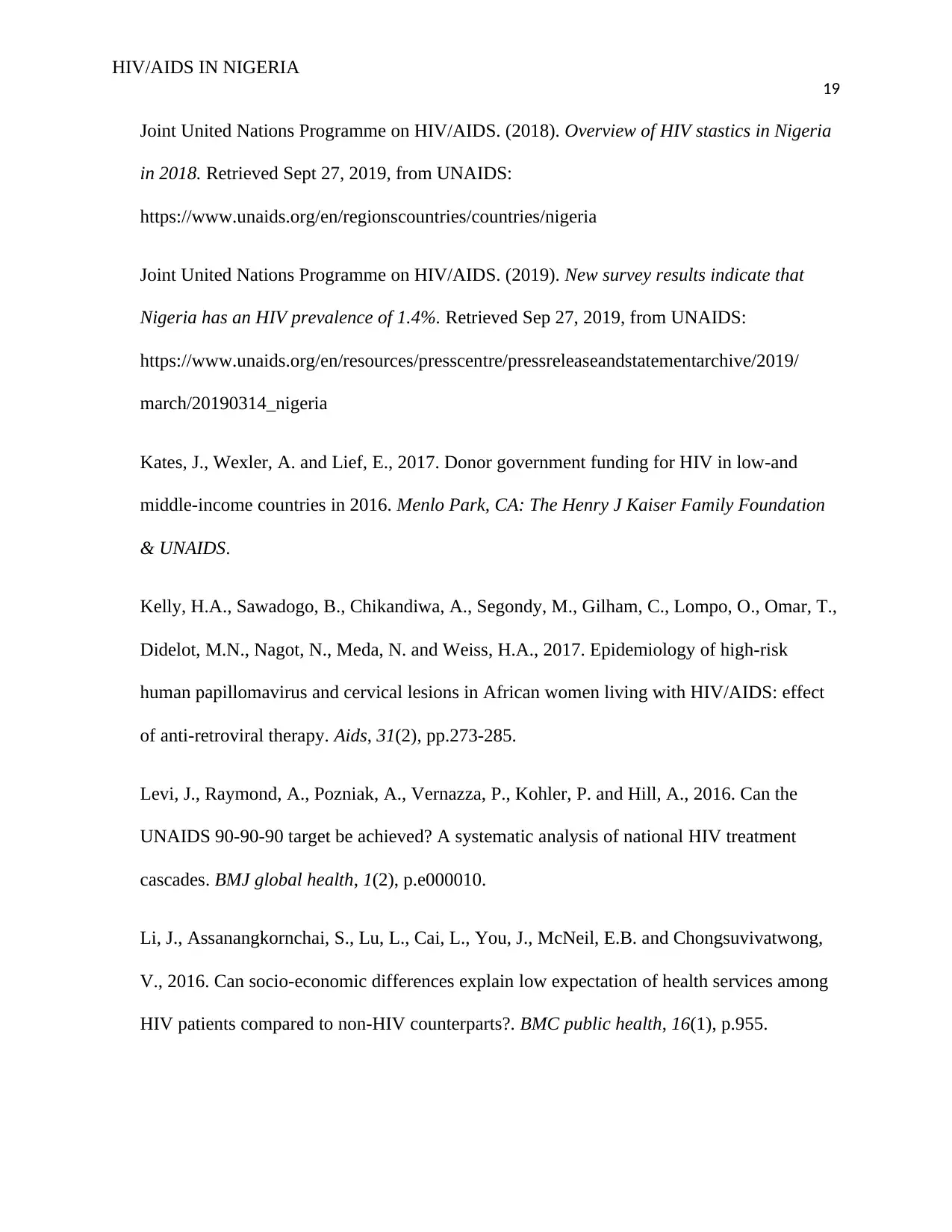
HIV/AIDS IN NIGERIA
19
Joint United Nations Programme on HIV/AIDS. (2018). Overview of HIV stastics in Nigeria
in 2018. Retrieved Sept 27, 2019, from UNAIDS:
https://www.unaids.org/en/regionscountries/countries/nigeria
Joint United Nations Programme on HIV/AIDS. (2019). New survey results indicate that
Nigeria has an HIV prevalence of 1.4%. Retrieved Sep 27, 2019, from UNAIDS:
https://www.unaids.org/en/resources/presscentre/pressreleaseandstatementarchive/2019/
march/20190314_nigeria
Kates, J., Wexler, A. and Lief, E., 2017. Donor government funding for HIV in low-and
middle-income countries in 2016. Menlo Park, CA: The Henry J Kaiser Family Foundation
& UNAIDS.
Kelly, H.A., Sawadogo, B., Chikandiwa, A., Segondy, M., Gilham, C., Lompo, O., Omar, T.,
Didelot, M.N., Nagot, N., Meda, N. and Weiss, H.A., 2017. Epidemiology of high-risk
human papillomavirus and cervical lesions in African women living with HIV/AIDS: effect
of anti-retroviral therapy. Aids, 31(2), pp.273-285.
Levi, J., Raymond, A., Pozniak, A., Vernazza, P., Kohler, P. and Hill, A., 2016. Can the
UNAIDS 90-90-90 target be achieved? A systematic analysis of national HIV treatment
cascades. BMJ global health, 1(2), p.e000010.
Li, J., Assanangkornchai, S., Lu, L., Cai, L., You, J., McNeil, E.B. and Chongsuvivatwong,
V., 2016. Can socio-economic differences explain low expectation of health services among
HIV patients compared to non-HIV counterparts?. BMC public health, 16(1), p.955.
19
Joint United Nations Programme on HIV/AIDS. (2018). Overview of HIV stastics in Nigeria
in 2018. Retrieved Sept 27, 2019, from UNAIDS:
https://www.unaids.org/en/regionscountries/countries/nigeria
Joint United Nations Programme on HIV/AIDS. (2019). New survey results indicate that
Nigeria has an HIV prevalence of 1.4%. Retrieved Sep 27, 2019, from UNAIDS:
https://www.unaids.org/en/resources/presscentre/pressreleaseandstatementarchive/2019/
march/20190314_nigeria
Kates, J., Wexler, A. and Lief, E., 2017. Donor government funding for HIV in low-and
middle-income countries in 2016. Menlo Park, CA: The Henry J Kaiser Family Foundation
& UNAIDS.
Kelly, H.A., Sawadogo, B., Chikandiwa, A., Segondy, M., Gilham, C., Lompo, O., Omar, T.,
Didelot, M.N., Nagot, N., Meda, N. and Weiss, H.A., 2017. Epidemiology of high-risk
human papillomavirus and cervical lesions in African women living with HIV/AIDS: effect
of anti-retroviral therapy. Aids, 31(2), pp.273-285.
Levi, J., Raymond, A., Pozniak, A., Vernazza, P., Kohler, P. and Hill, A., 2016. Can the
UNAIDS 90-90-90 target be achieved? A systematic analysis of national HIV treatment
cascades. BMJ global health, 1(2), p.e000010.
Li, J., Assanangkornchai, S., Lu, L., Cai, L., You, J., McNeil, E.B. and Chongsuvivatwong,
V., 2016. Can socio-economic differences explain low expectation of health services among
HIV patients compared to non-HIV counterparts?. BMC public health, 16(1), p.955.
Paraphrase This Document
Need a fresh take? Get an instant paraphrase of this document with our AI Paraphraser
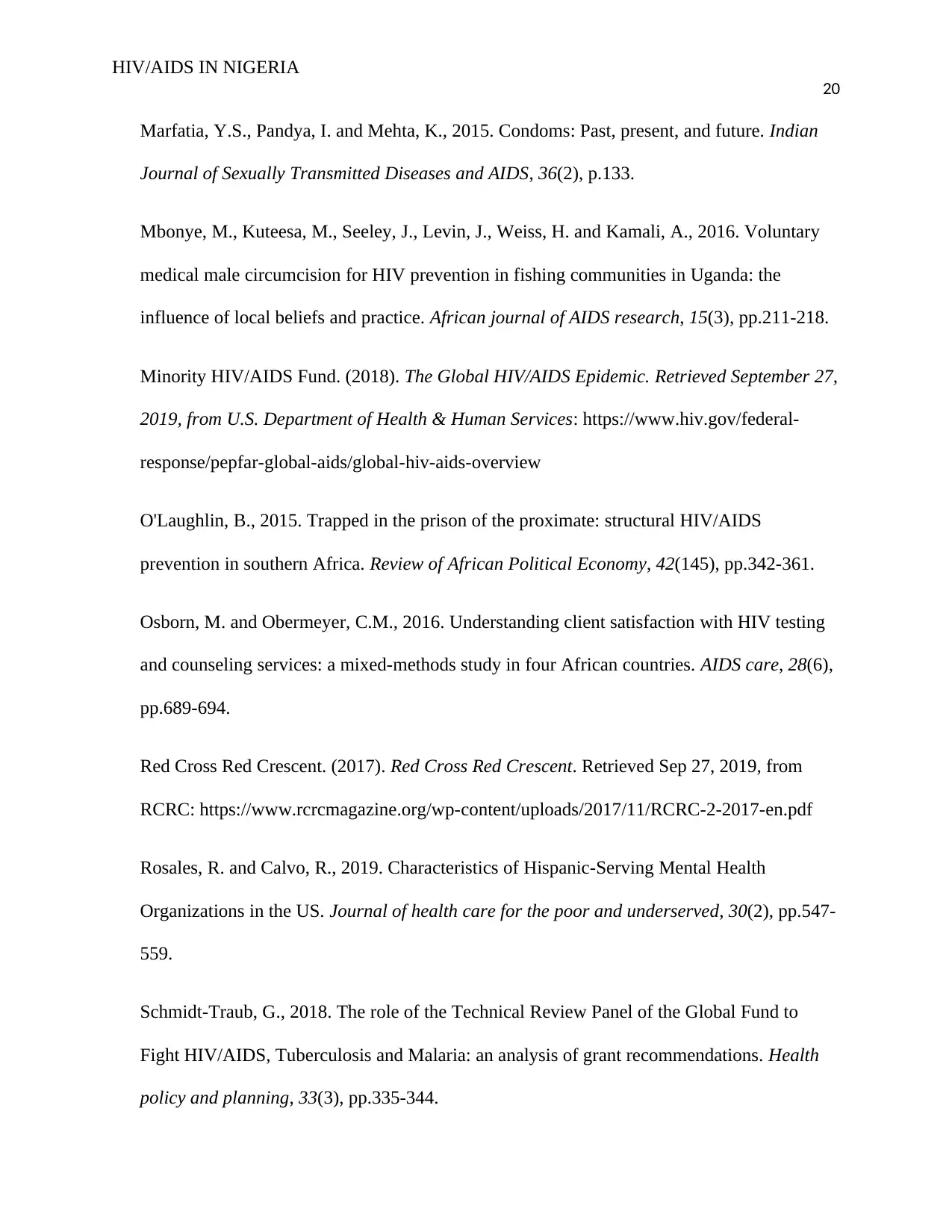
HIV/AIDS IN NIGERIA
20
Marfatia, Y.S., Pandya, I. and Mehta, K., 2015. Condoms: Past, present, and future. Indian
Journal of Sexually Transmitted Diseases and AIDS, 36(2), p.133.
Mbonye, M., Kuteesa, M., Seeley, J., Levin, J., Weiss, H. and Kamali, A., 2016. Voluntary
medical male circumcision for HIV prevention in fishing communities in Uganda: the
influence of local beliefs and practice. African journal of AIDS research, 15(3), pp.211-218.
Minority HIV/AIDS Fund. (2018). The Global HIV/AIDS Epidemic. Retrieved September 27,
2019, from U.S. Department of Health & Human Services: https://www.hiv.gov/federal-
response/pepfar-global-aids/global-hiv-aids-overview
O'Laughlin, B., 2015. Trapped in the prison of the proximate: structural HIV/AIDS
prevention in southern Africa. Review of African Political Economy, 42(145), pp.342-361.
Osborn, M. and Obermeyer, C.M., 2016. Understanding client satisfaction with HIV testing
and counseling services: a mixed-methods study in four African countries. AIDS care, 28(6),
pp.689-694.
Red Cross Red Crescent. (2017). Red Cross Red Crescent. Retrieved Sep 27, 2019, from
RCRC: https://www.rcrcmagazine.org/wp-content/uploads/2017/11/RCRC-2-2017-en.pdf
Rosales, R. and Calvo, R., 2019. Characteristics of Hispanic-Serving Mental Health
Organizations in the US. Journal of health care for the poor and underserved, 30(2), pp.547-
559.
Schmidt-Traub, G., 2018. The role of the Technical Review Panel of the Global Fund to
Fight HIV/AIDS, Tuberculosis and Malaria: an analysis of grant recommendations. Health
policy and planning, 33(3), pp.335-344.
20
Marfatia, Y.S., Pandya, I. and Mehta, K., 2015. Condoms: Past, present, and future. Indian
Journal of Sexually Transmitted Diseases and AIDS, 36(2), p.133.
Mbonye, M., Kuteesa, M., Seeley, J., Levin, J., Weiss, H. and Kamali, A., 2016. Voluntary
medical male circumcision for HIV prevention in fishing communities in Uganda: the
influence of local beliefs and practice. African journal of AIDS research, 15(3), pp.211-218.
Minority HIV/AIDS Fund. (2018). The Global HIV/AIDS Epidemic. Retrieved September 27,
2019, from U.S. Department of Health & Human Services: https://www.hiv.gov/federal-
response/pepfar-global-aids/global-hiv-aids-overview
O'Laughlin, B., 2015. Trapped in the prison of the proximate: structural HIV/AIDS
prevention in southern Africa. Review of African Political Economy, 42(145), pp.342-361.
Osborn, M. and Obermeyer, C.M., 2016. Understanding client satisfaction with HIV testing
and counseling services: a mixed-methods study in four African countries. AIDS care, 28(6),
pp.689-694.
Red Cross Red Crescent. (2017). Red Cross Red Crescent. Retrieved Sep 27, 2019, from
RCRC: https://www.rcrcmagazine.org/wp-content/uploads/2017/11/RCRC-2-2017-en.pdf
Rosales, R. and Calvo, R., 2019. Characteristics of Hispanic-Serving Mental Health
Organizations in the US. Journal of health care for the poor and underserved, 30(2), pp.547-
559.
Schmidt-Traub, G., 2018. The role of the Technical Review Panel of the Global Fund to
Fight HIV/AIDS, Tuberculosis and Malaria: an analysis of grant recommendations. Health
policy and planning, 33(3), pp.335-344.
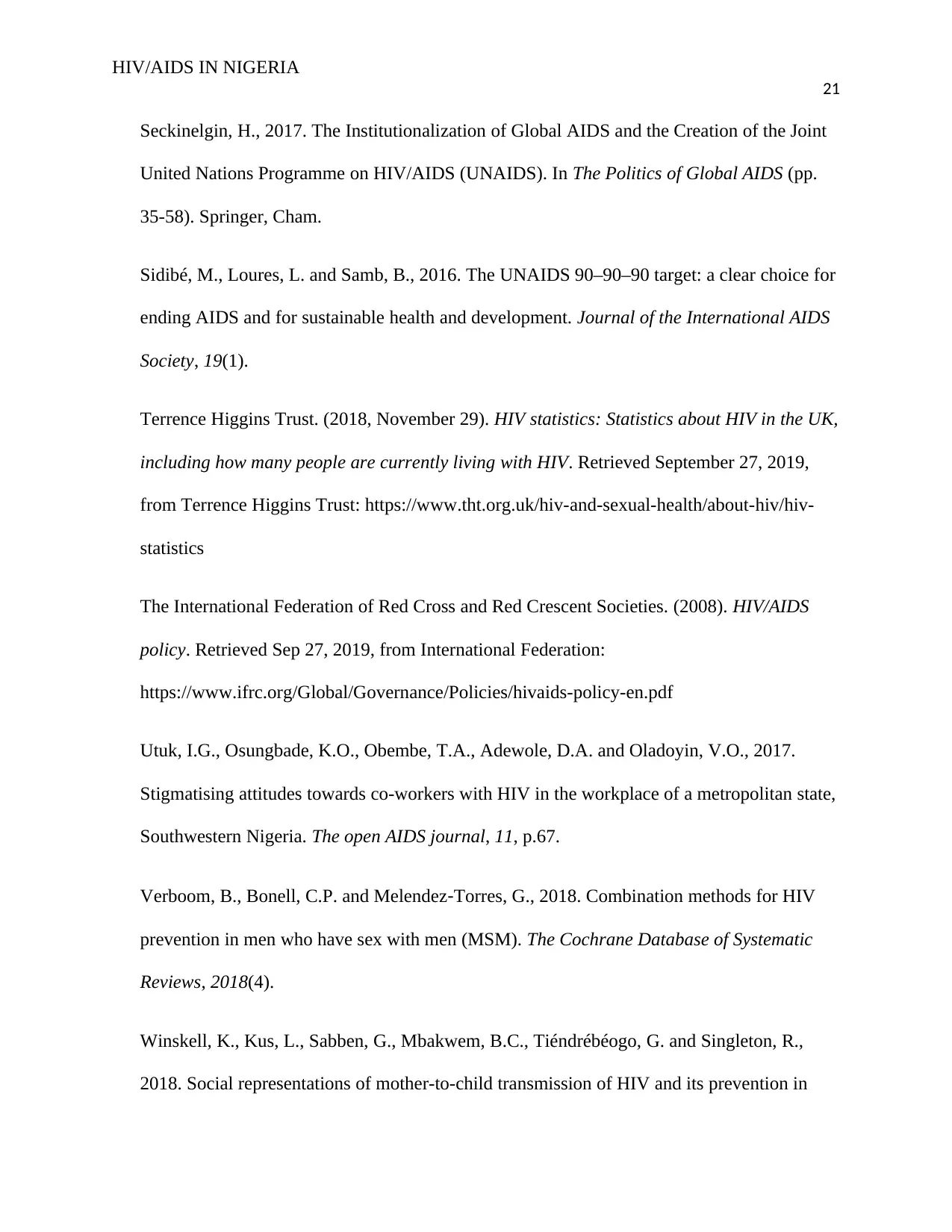
HIV/AIDS IN NIGERIA
21
Seckinelgin, H., 2017. The Institutionalization of Global AIDS and the Creation of the Joint
United Nations Programme on HIV/AIDS (UNAIDS). In The Politics of Global AIDS (pp.
35-58). Springer, Cham.
Sidibé, M., Loures, L. and Samb, B., 2016. The UNAIDS 90–90–90 target: a clear choice for
ending AIDS and for sustainable health and development. Journal of the International AIDS
Society, 19(1).
Terrence Higgins Trust. (2018, November 29). HIV statistics: Statistics about HIV in the UK,
including how many people are currently living with HIV. Retrieved September 27, 2019,
from Terrence Higgins Trust: https://www.tht.org.uk/hiv-and-sexual-health/about-hiv/hiv-
statistics
The International Federation of Red Cross and Red Crescent Societies. (2008). HIV/AIDS
policy. Retrieved Sep 27, 2019, from International Federation:
https://www.ifrc.org/Global/Governance/Policies/hivaids-policy-en.pdf
Utuk, I.G., Osungbade, K.O., Obembe, T.A., Adewole, D.A. and Oladoyin, V.O., 2017.
Stigmatising attitudes towards co-workers with HIV in the workplace of a metropolitan state,
Southwestern Nigeria. The open AIDS journal, 11, p.67.
Verboom, B., Bonell, C.P. and Melendez‐Torres, G., 2018. Combination methods for HIV
prevention in men who have sex with men (MSM). The Cochrane Database of Systematic
Reviews, 2018(4).
Winskell, K., Kus, L., Sabben, G., Mbakwem, B.C., Tiéndrébéogo, G. and Singleton, R.,
2018. Social representations of mother-to-child transmission of HIV and its prevention in
21
Seckinelgin, H., 2017. The Institutionalization of Global AIDS and the Creation of the Joint
United Nations Programme on HIV/AIDS (UNAIDS). In The Politics of Global AIDS (pp.
35-58). Springer, Cham.
Sidibé, M., Loures, L. and Samb, B., 2016. The UNAIDS 90–90–90 target: a clear choice for
ending AIDS and for sustainable health and development. Journal of the International AIDS
Society, 19(1).
Terrence Higgins Trust. (2018, November 29). HIV statistics: Statistics about HIV in the UK,
including how many people are currently living with HIV. Retrieved September 27, 2019,
from Terrence Higgins Trust: https://www.tht.org.uk/hiv-and-sexual-health/about-hiv/hiv-
statistics
The International Federation of Red Cross and Red Crescent Societies. (2008). HIV/AIDS
policy. Retrieved Sep 27, 2019, from International Federation:
https://www.ifrc.org/Global/Governance/Policies/hivaids-policy-en.pdf
Utuk, I.G., Osungbade, K.O., Obembe, T.A., Adewole, D.A. and Oladoyin, V.O., 2017.
Stigmatising attitudes towards co-workers with HIV in the workplace of a metropolitan state,
Southwestern Nigeria. The open AIDS journal, 11, p.67.
Verboom, B., Bonell, C.P. and Melendez‐Torres, G., 2018. Combination methods for HIV
prevention in men who have sex with men (MSM). The Cochrane Database of Systematic
Reviews, 2018(4).
Winskell, K., Kus, L., Sabben, G., Mbakwem, B.C., Tiéndrébéogo, G. and Singleton, R.,
2018. Social representations of mother-to-child transmission of HIV and its prevention in
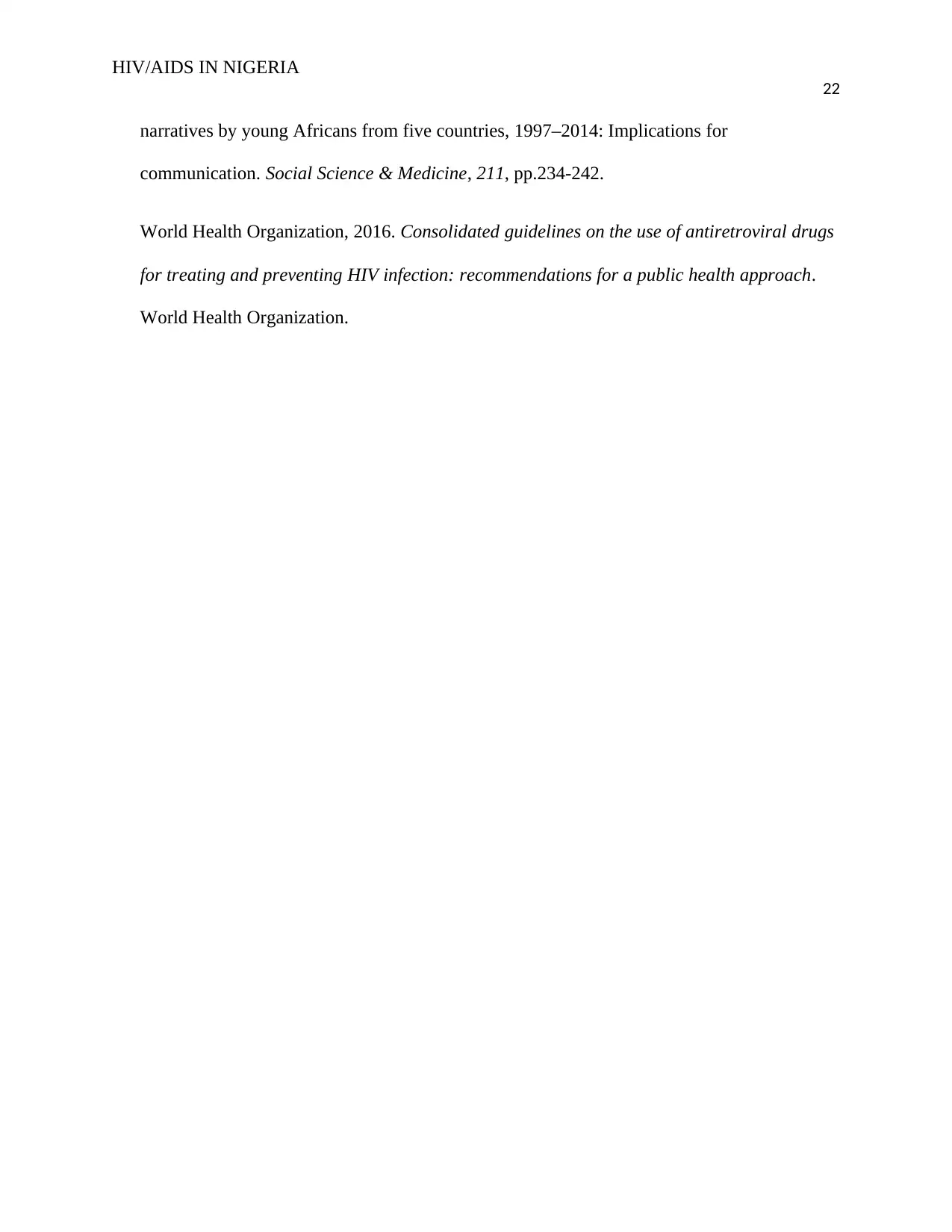
HIV/AIDS IN NIGERIA
22
narratives by young Africans from five countries, 1997–2014: Implications for
communication. Social Science & Medicine, 211, pp.234-242.
World Health Organization, 2016. Consolidated guidelines on the use of antiretroviral drugs
for treating and preventing HIV infection: recommendations for a public health approach.
World Health Organization.
22
narratives by young Africans from five countries, 1997–2014: Implications for
communication. Social Science & Medicine, 211, pp.234-242.
World Health Organization, 2016. Consolidated guidelines on the use of antiretroviral drugs
for treating and preventing HIV infection: recommendations for a public health approach.
World Health Organization.
1 out of 22
Related Documents
Your All-in-One AI-Powered Toolkit for Academic Success.
+13062052269
info@desklib.com
Available 24*7 on WhatsApp / Email
![[object Object]](/_next/static/media/star-bottom.7253800d.svg)
Unlock your academic potential
© 2024 | Zucol Services PVT LTD | All rights reserved.





